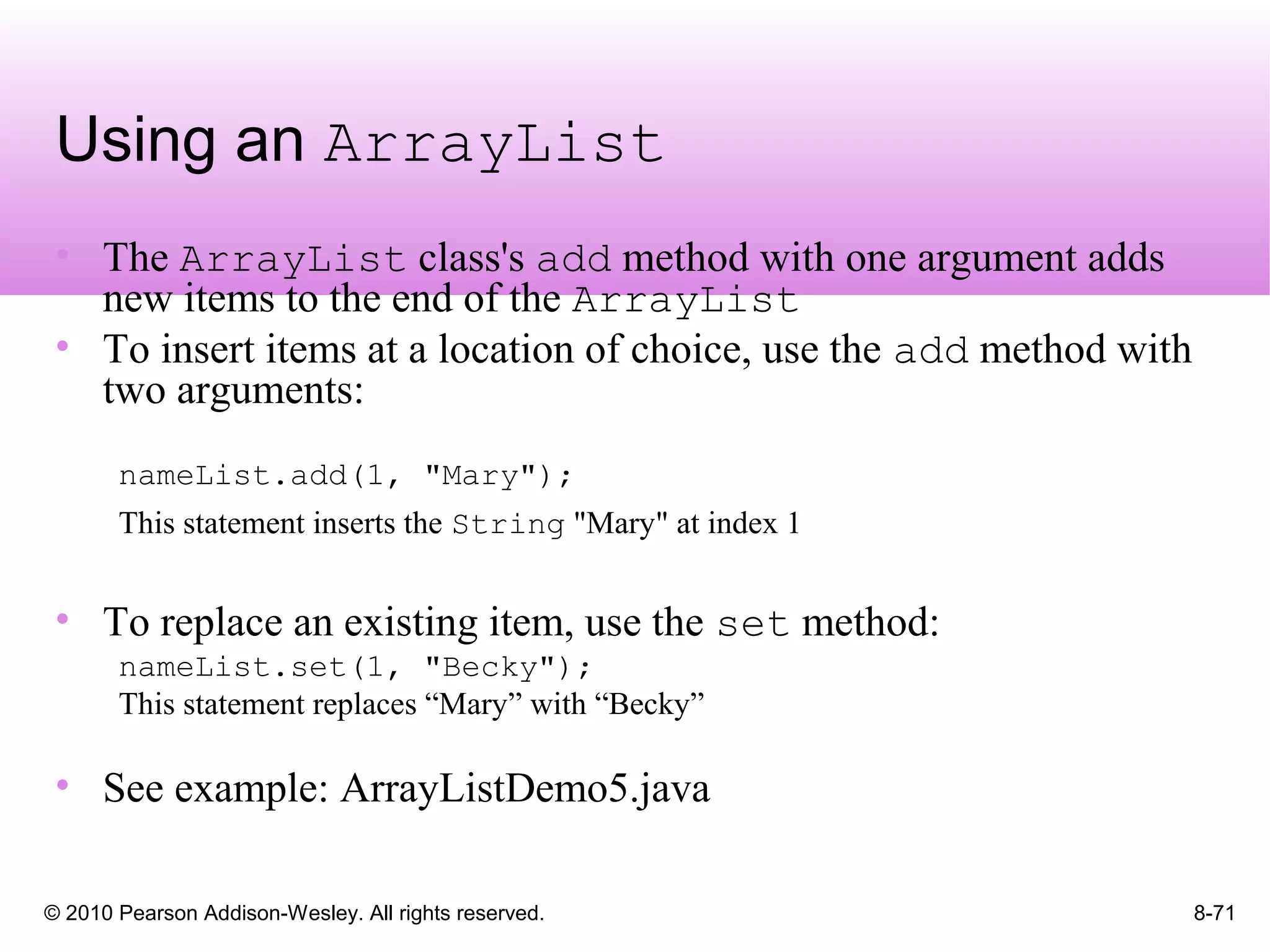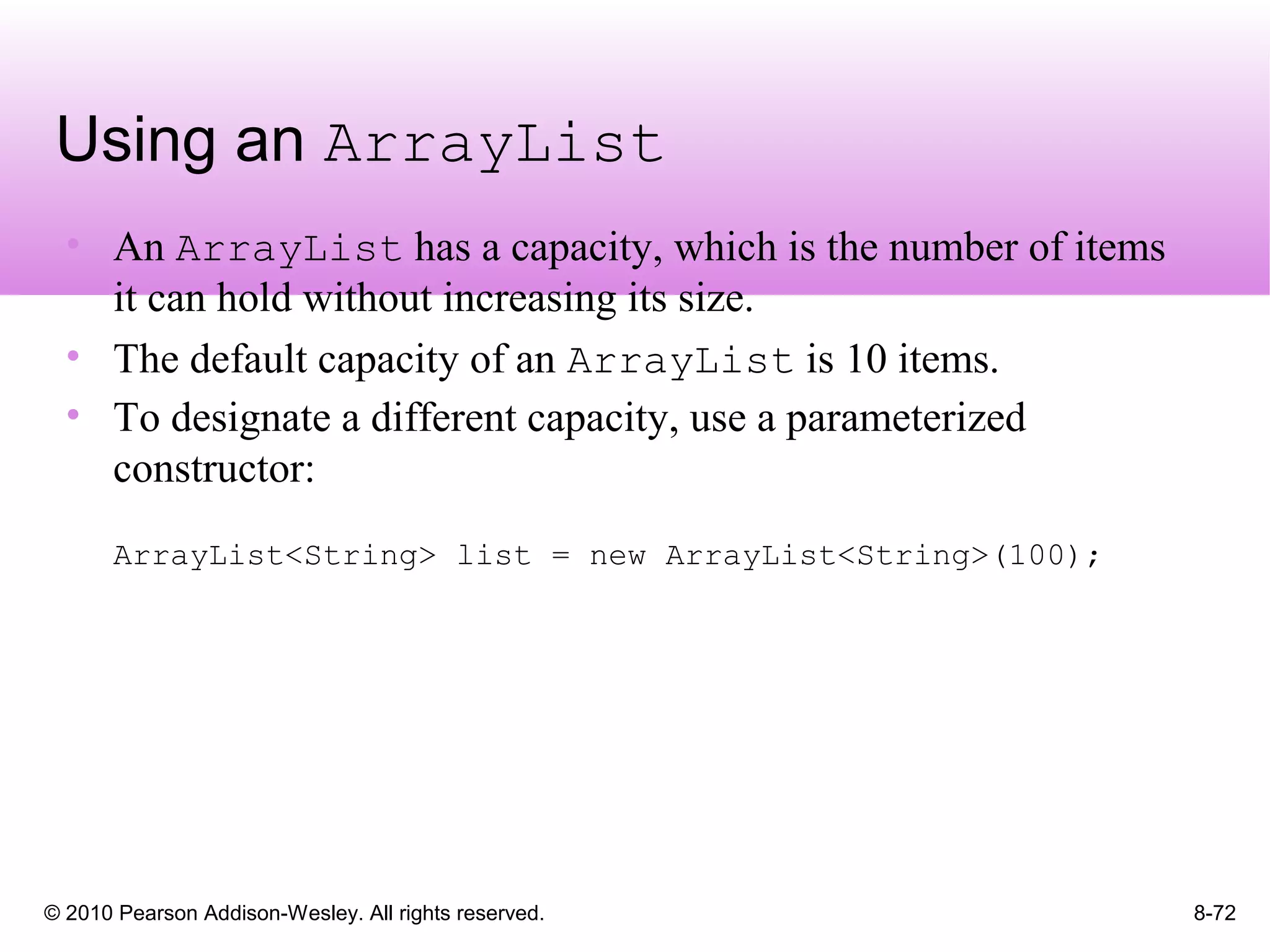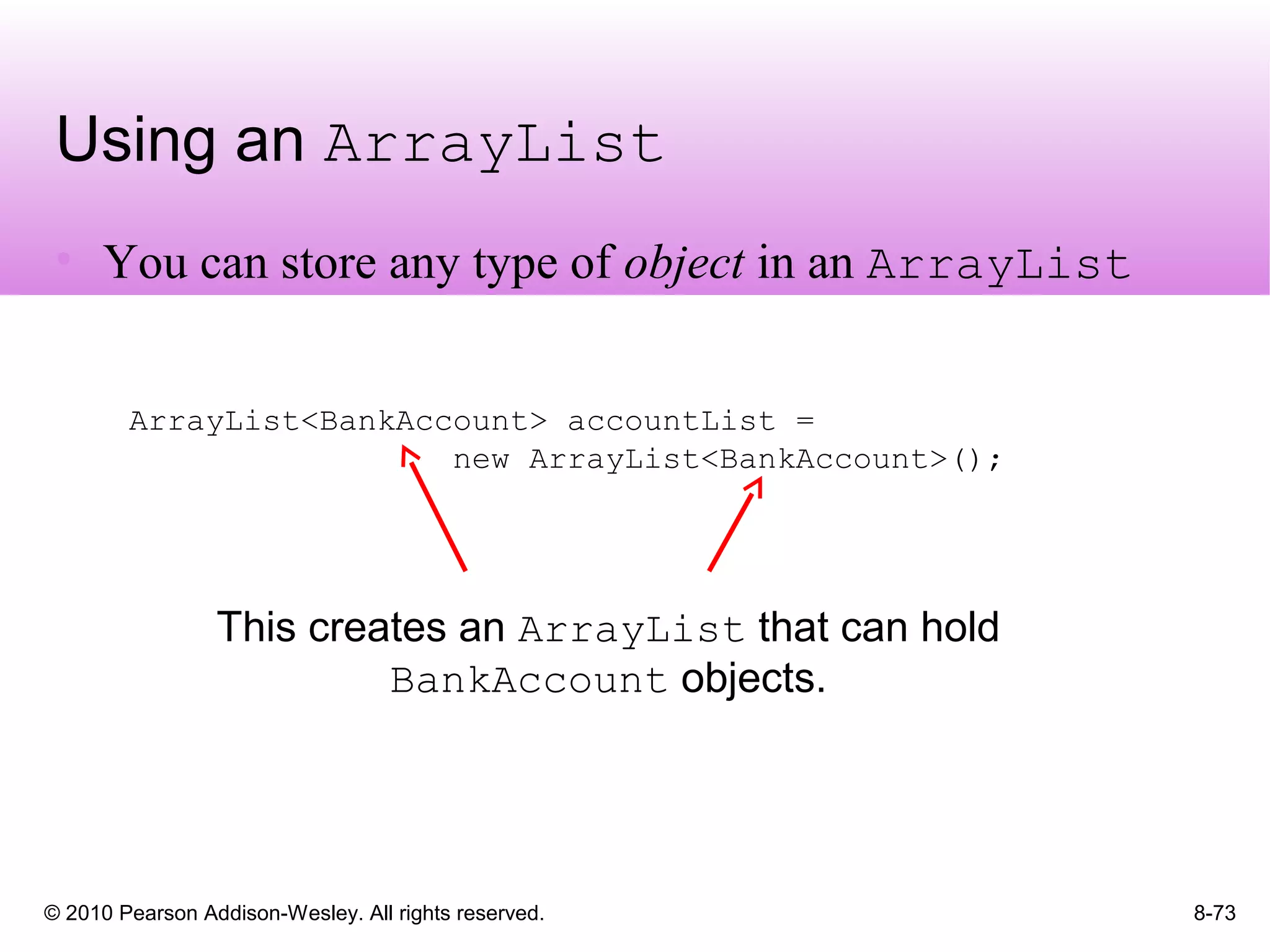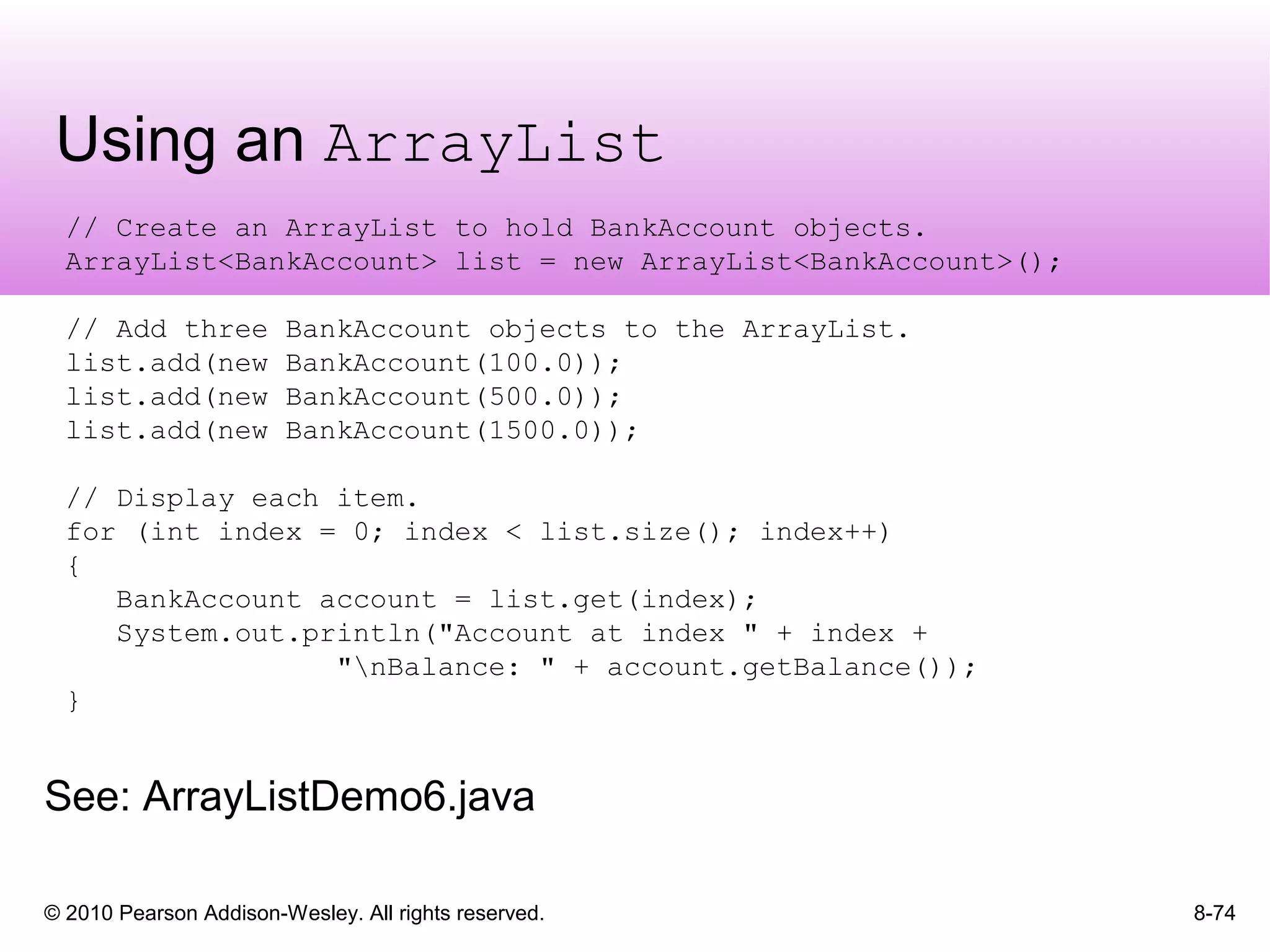The document discusses chapter 8 of the book "Starting Out with Java: From Control Structures through Objects" by Tony Gaddis. Chapter 8 covers arrays and the ArrayList class. It introduces arrays, how to create and access array elements, common array operations like finding highest/lowest values and summing elements. It also discusses passing arrays to methods, returning arrays from methods, string arrays, and using arrays with files.
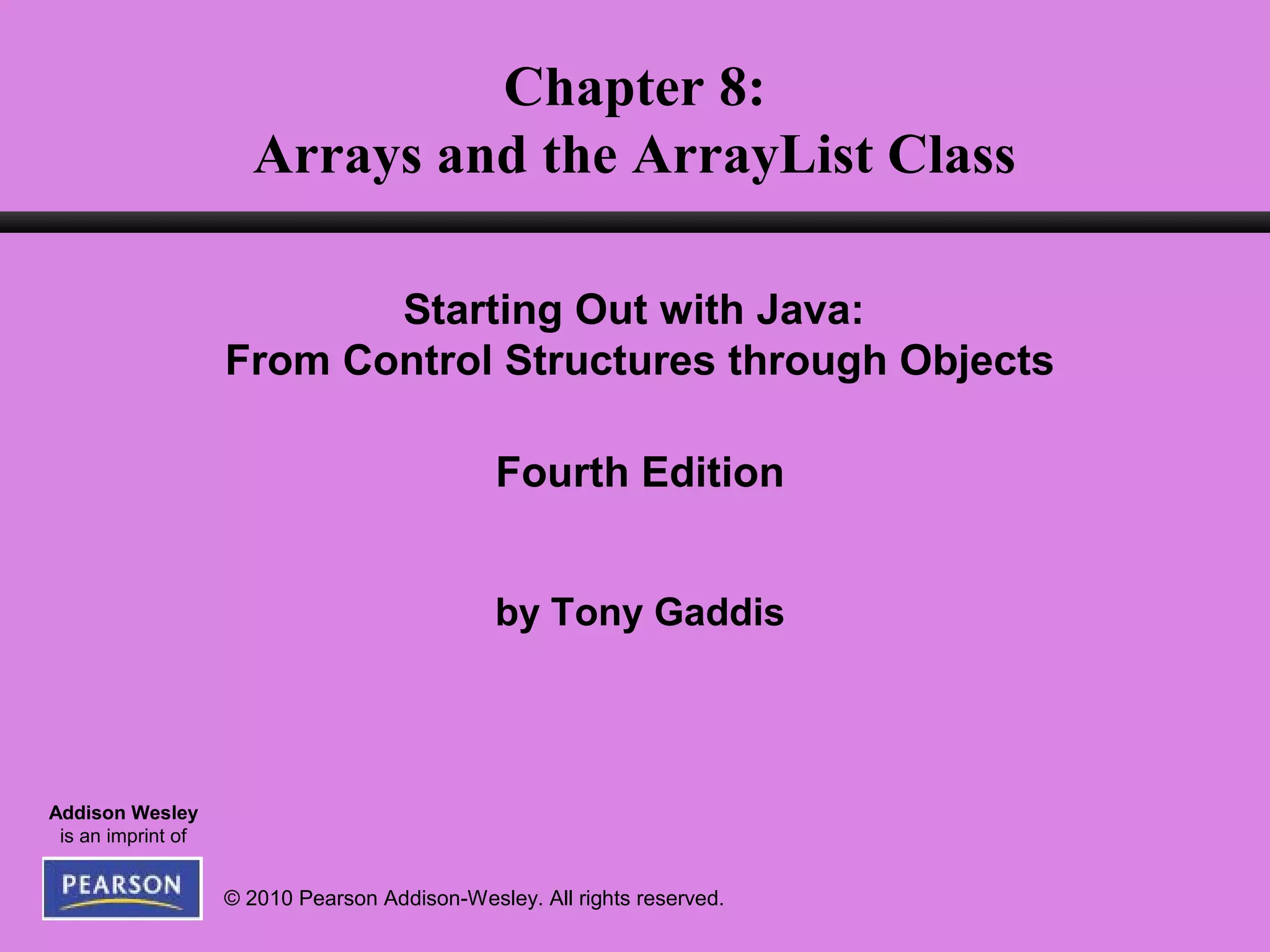

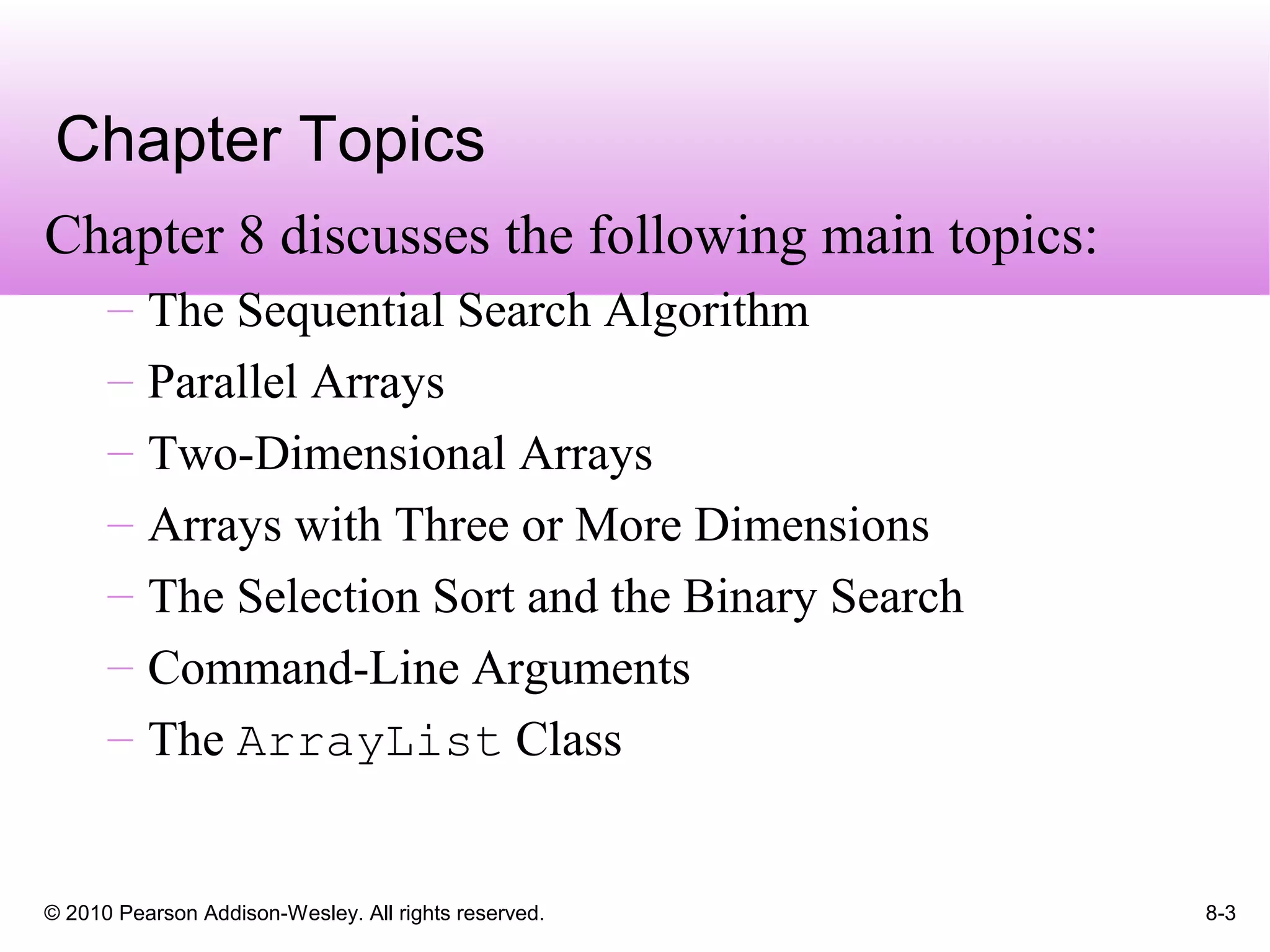
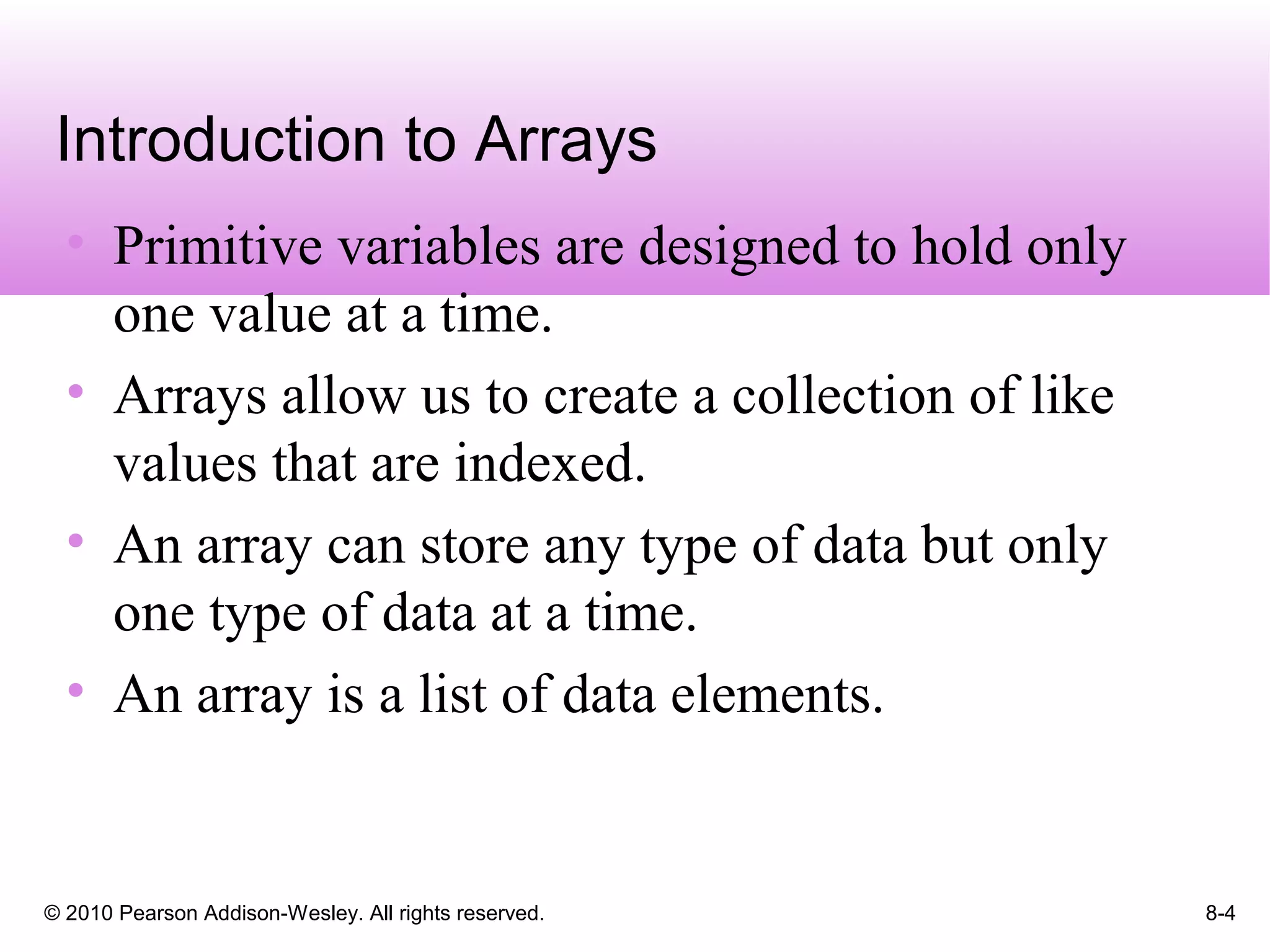
![© 2010 Pearson Addison-Wesley. All rights reserved. 8-5
Creating Arrays
• An array is an object so it needs an object reference.
// Declare a reference to an array that will hold integers.
int[] numbers;
• The next step creates the array and assigns its address to the
numbers variable.
// Create a new array that will hold 6 integers.
numbers = new int[6];
Array element values are initialized to 0.
Array indexes always start at 0.
0
index 0
0
index 1
0
index 2
0
index 3
0
index 4
0
index 5](https://image.slidesharecdn.com/csogaddisjavachapter8-130522082930-phpapp02/75/Cso-gaddis-java_chapter8-5-2048.jpg)
![© 2010 Pearson Addison-Wesley. All rights reserved. 8-6
Creating Arrays
• It is possible to declare an array reference and create it
in the same statement.
int[] numbers = new int[6];
• Arrays may be of any type.
float[] temperatures = new float[100];
char[] letters = new char[41];
long[] units = new long[50];
double[] sizes = new double[1200];](https://image.slidesharecdn.com/csogaddisjavachapter8-130522082930-phpapp02/75/Cso-gaddis-java_chapter8-6-2048.jpg)
![© 2010 Pearson Addison-Wesley. All rights reserved. 8-7
Creating Arrays
• The array size must be a non-negative number.
• It may be a literal value, a constant, or variable.
final int ARRAY_SIZE = 6;
int[] numbers = new int[ARRAY_SIZE];
• Once created, an array size is fixed and cannot be
changed.](https://image.slidesharecdn.com/csogaddisjavachapter8-130522082930-phpapp02/75/Cso-gaddis-java_chapter8-7-2048.jpg)
![© 2010 Pearson Addison-Wesley. All rights reserved. 8-8
Accessing the Elements of an Array
• An array is accessed by:
– the reference name
– a subscript that identifies which element in the array to
access.
numbers[0] = 20; //pronounced "numbers sub zero"
numbers[0]
0
numbers[1]
0
numbers[2]
0
numbers[3]
0
numbers[4]
0
numbers[5]
20](https://image.slidesharecdn.com/csogaddisjavachapter8-130522082930-phpapp02/75/Cso-gaddis-java_chapter8-8-2048.jpg)
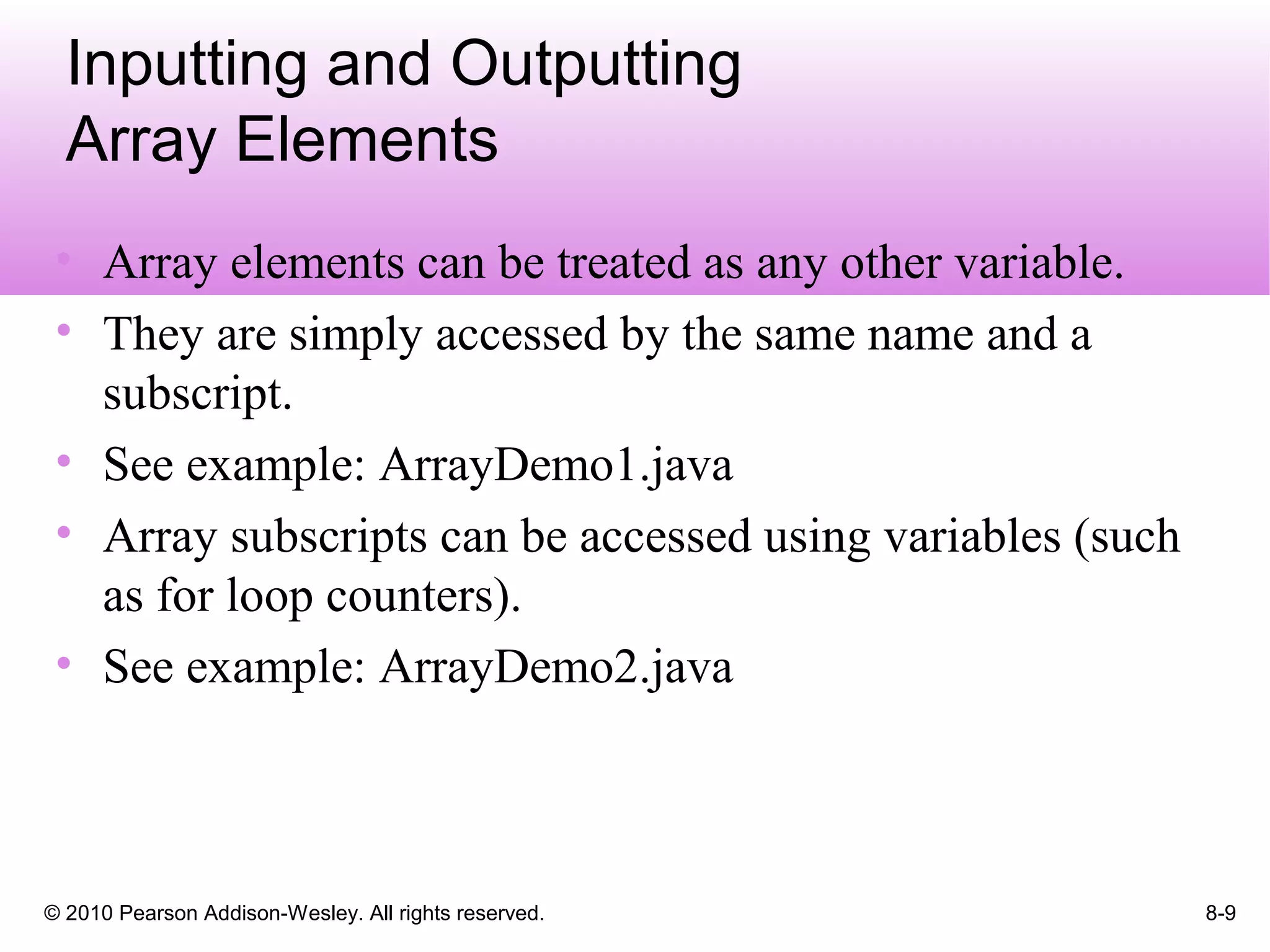
![© 2010 Pearson Addison-Wesley. All rights reserved. 8-10
Bounds Checking
• Array indexes always start at zero and continue to
(array length - 1).
int values = new int[10];
• This array would have indexes 0 through 9.
• See example: InvalidSubscript.java
• In for loops, it is typical to use i, j, and k as counting
variables.
– It might help to think of i as representing the word index.](https://image.slidesharecdn.com/csogaddisjavachapter8-130522082930-phpapp02/75/Cso-gaddis-java_chapter8-10-2048.jpg)
![© 2010 Pearson Addison-Wesley. All rights reserved. 8-11
Off-by-One Errors
• It is very easy to be off-by-one when accessing arrays.
// This code has an off-by-one error.
int[] numbers = new int[100];
for (int i = 1; i <= 100; i++)
numbers[i] = 99;
• Here, the equal sign allows the loop to continue on to index
100, where 99 is the last index in the array.
• This code would throw an
ArrayIndexOutOfBoundsException.](https://image.slidesharecdn.com/csogaddisjavachapter8-130522082930-phpapp02/75/Cso-gaddis-java_chapter8-11-2048.jpg)
![© 2010 Pearson Addison-Wesley. All rights reserved. 8-12
Array Initialization
• When relatively few items need to be initialized, an
initialization list can be used to initialize the array.
int[]days = {31, 28, 31, 30, 31, 30, 31, 31, 30, 31, 30, 31};
• The numbers in the list are stored in the array in order:
– days[0] is assigned 31,
– days[1] is assigned 28,
– days[2] is assigned 31,
– days[3] is assigned 30,
– etc.
• See example: ArrayInitialization.java](https://image.slidesharecdn.com/csogaddisjavachapter8-130522082930-phpapp02/75/Cso-gaddis-java_chapter8-12-2048.jpg)
![© 2010 Pearson Addison-Wesley. All rights reserved. 8-13
Alternate Array Declaration
• Previously we showed arrays being declared:
int[] numbers;
– However, the brackets can also go here:
int numbers[];
– These are equivalent but the first style is typical.
• Multiple arrays can be declared on the same line.
int[] numbers, codes, scores;
• With the alternate notation each variable must have brackets.
int numbers[], codes[], scores;
– The scores variable in this instance is simply an int variable.](https://image.slidesharecdn.com/csogaddisjavachapter8-130522082930-phpapp02/75/Cso-gaddis-java_chapter8-13-2048.jpg)
![© 2010 Pearson Addison-Wesley. All rights reserved. 8-14
Processing Array Contents
• Processing data in an array is the same as any other variable.
grossPay = hours[3] * payRate;
• Pre and post increment works the same:
int[] score = {7, 8, 9, 10, 11};
++score[2]; // Pre-increment operation
score[4]++; // Post-increment operation
• See example: PayArray.java](https://image.slidesharecdn.com/csogaddisjavachapter8-130522082930-phpapp02/75/Cso-gaddis-java_chapter8-14-2048.jpg)
![© 2010 Pearson Addison-Wesley. All rights reserved. 8-15
Processing Array Contents
• Array elements can be used in relational operations:
if(cost[20] < cost[0])
{
//statements
}
• They can be used as loop conditions:
while(value[count] != 0)
{
//statements
}](https://image.slidesharecdn.com/csogaddisjavachapter8-130522082930-phpapp02/75/Cso-gaddis-java_chapter8-15-2048.jpg)
![© 2010 Pearson Addison-Wesley. All rights reserved. 8-16
Array Length
• Arrays are objects and provide a public field named length
that is a constant that can be tested.
double[] temperatures = new double[25];
– The length of this array is 25.
• The length of an array can be obtained via its length
constant.
int size = temperatures.length;
– The variable size will contain 25.](https://image.slidesharecdn.com/csogaddisjavachapter8-130522082930-phpapp02/75/Cso-gaddis-java_chapter8-16-2048.jpg)
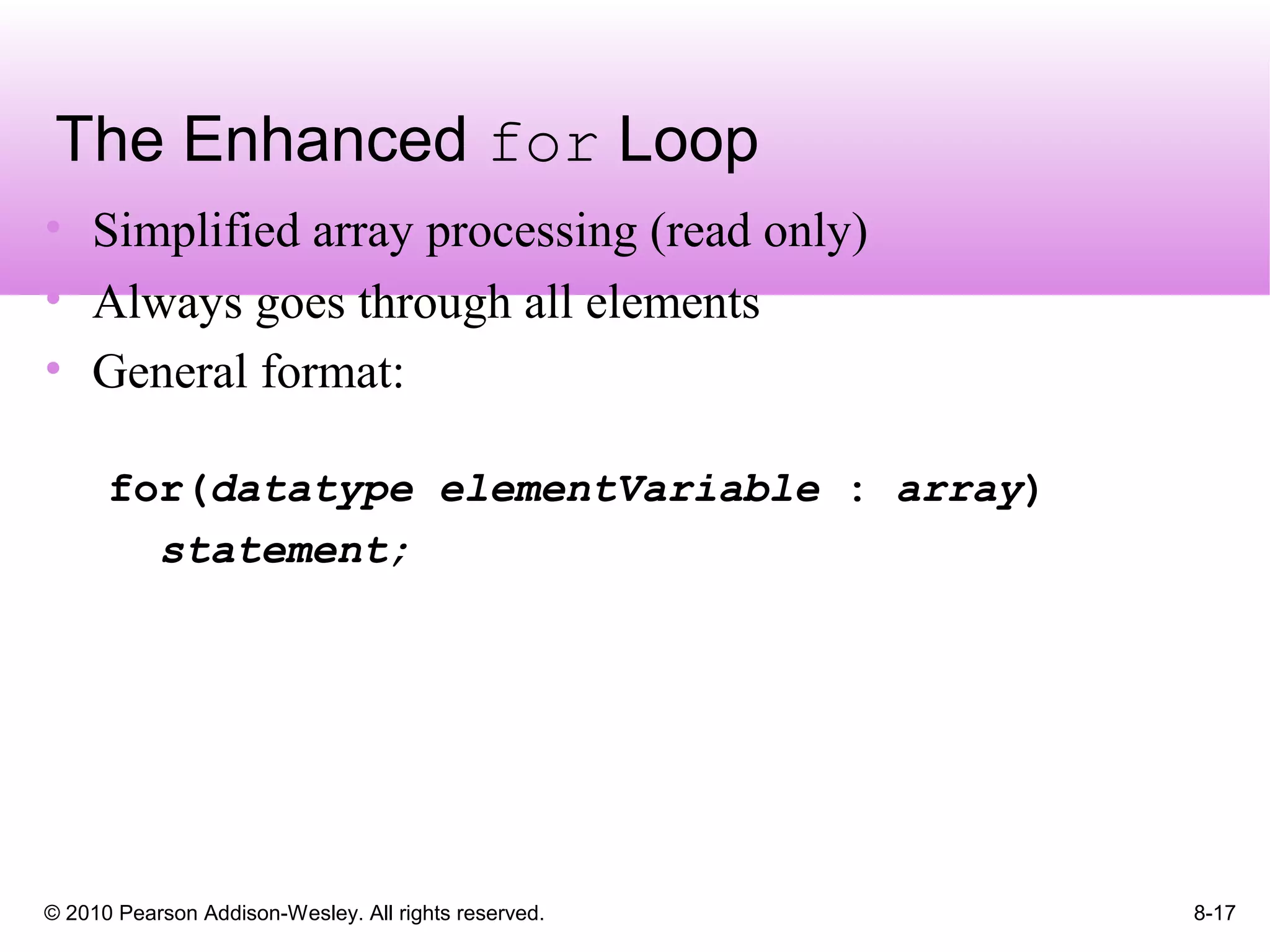
![© 2010 Pearson Addison-Wesley. All rights reserved. 8-18
The Enhanced for Loop
Example:
int[] numbers = {3, 6, 9};
For(int val : numbers)
{
System.out.println("The next value is " +
val);
}](https://image.slidesharecdn.com/csogaddisjavachapter8-130522082930-phpapp02/75/Cso-gaddis-java_chapter8-18-2048.jpg)
![© 2010 Pearson Addison-Wesley. All rights reserved. 8-19
Array Size
• The length constant can be used in a loop
to provide automatic bounding.
for(int i = 0; i < temperatures.length; i++)
{
System.out.println("Temperature " + i ": "
+ temperatures[i]);
}
Index subscripts start at 0 and end at one less than the
array length.](https://image.slidesharecdn.com/csogaddisjavachapter8-130522082930-phpapp02/75/Cso-gaddis-java_chapter8-19-2048.jpg)
![© 2010 Pearson Addison-Wesley. All rights reserved. 8-20
Array Size
• You can let the user specify the size of an array:
int numTests;
int[] tests;
Scanner keyboard = new Scanner(System.in);
System.out.print("How many tests do you have? ");
numTests = keyboard.nextInt();
tests = new int[numTests];
• See example: DisplayTestScores.java](https://image.slidesharecdn.com/csogaddisjavachapter8-130522082930-phpapp02/75/Cso-gaddis-java_chapter8-20-2048.jpg)
![© 2010 Pearson Addison-Wesley. All rights reserved. 8-21
Reassigning Array References
• An array reference can be assigned to another array of
the same type.
// Create an array referenced by the numbers variable.
int[] numbers = new int[10];
// Reassign numbers to a new array.
numbers = new int[5];
• If the first (10 element) array no longer has a reference
to it, it will be garbage collected.](https://image.slidesharecdn.com/csogaddisjavachapter8-130522082930-phpapp02/75/Cso-gaddis-java_chapter8-21-2048.jpg)
![© 2010 Pearson Addison-Wesley. All rights reserved. 8-22
Reassigning Array References
Address
The numbers variable
holds the address of an
int array.
int[] numbers = new int[10];](https://image.slidesharecdn.com/csogaddisjavachapter8-130522082930-phpapp02/75/Cso-gaddis-java_chapter8-22-2048.jpg)
![© 2010 Pearson Addison-Wesley. All rights reserved. 8-23
Reassigning Array References
Address
The numbers variable
holds the address of an
int array.
numbers = new int[5];
This array gets marked for
garbage collection](https://image.slidesharecdn.com/csogaddisjavachapter8-130522082930-phpapp02/75/Cso-gaddis-java_chapter8-23-2048.jpg)
![© 2010 Pearson Addison-Wesley. All rights reserved. 8-24
Copying Arrays
• This is not the way to copy an array.
int[] array1 = { 2, 4, 6, 8, 10 };
int[] array2 = array1; // This does not copy array1.
2
Address
array1 holds an
address to the array
Address
array2 holds an
address to the array
4 6 8 10
Example:
SameArray.java](https://image.slidesharecdn.com/csogaddisjavachapter8-130522082930-phpapp02/75/Cso-gaddis-java_chapter8-24-2048.jpg)
![© 2010 Pearson Addison-Wesley. All rights reserved. 8-25
Copying Arrays
• You cannot copy an array by merely assigning one
reference variable to another.
• You need to copy the individual elements of one array to
another.
int[] firstArray = {5, 10, 15, 20, 25 };
int[] secondArray = new int[5];
for (int i = 0; i < firstArray.length; i++)
secondArray[i] = firstArray[i];
• This code copies each element of firstArray to the
corresponding element of secondArray.](https://image.slidesharecdn.com/csogaddisjavachapter8-130522082930-phpapp02/75/Cso-gaddis-java_chapter8-25-2048.jpg)
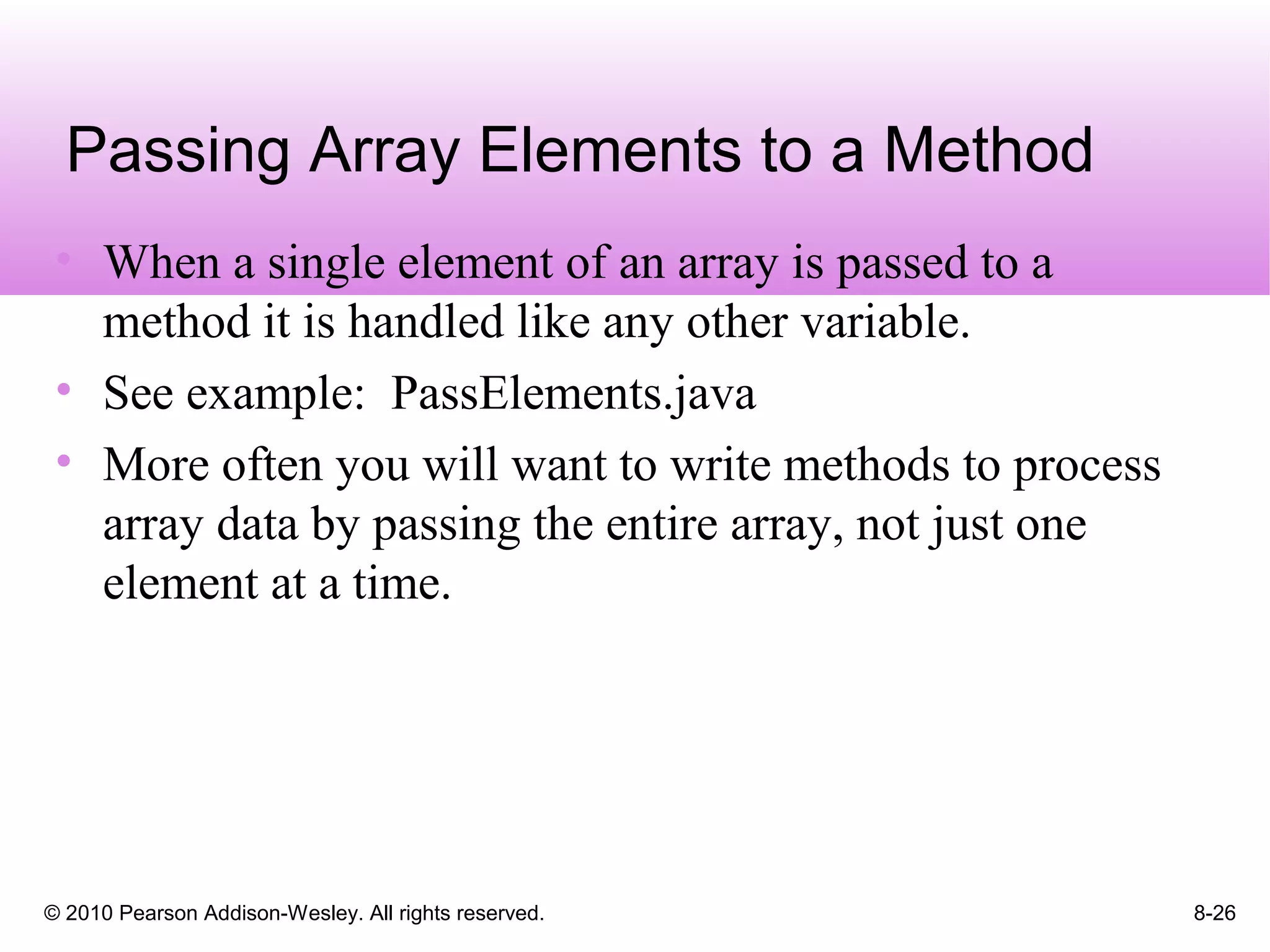
![© 2010 Pearson Addison-Wesley. All rights reserved. 8-27
Passing Arrays as Arguments
• Arrays are objects.
• Their references can be passed to methods like any
other object reference variable.
5 10 15 20 25
Address
showArray(numbers); 30 35 40
public static void showArray(int[] array)
{
for (int i = 0; i < array.length; i++)
System.out.print(array[i] + " ");
}
Example: PassArray.java](https://image.slidesharecdn.com/csogaddisjavachapter8-130522082930-phpapp02/75/Cso-gaddis-java_chapter8-27-2048.jpg)
![© 2010 Pearson Addison-Wesley. All rights reserved. 8-28
Comparing Arrays
• The == operator determines only whether array
references point to the same array object.
int[] firstArray = { 5, 10, 15, 20, 25 };
int[] secondArray = { 5, 10, 15, 20, 25 };
if (firstArray == secondArray) // This is a mistake.
System.out.println("The arrays are the same.");
else
System.out.println("The arrays are not the same.");](https://image.slidesharecdn.com/csogaddisjavachapter8-130522082930-phpapp02/75/Cso-gaddis-java_chapter8-28-2048.jpg)
![© 2010 Pearson Addison-Wesley. All rights reserved.
Comparing Arrays: Example
8-29
int[] firstArray = { 2, 4, 6, 8, 10 };
int[] secondArray = { 2, 4, 6, 8, 10 };
boolean arraysEqual = true;
int i = 0;
// First determine whether the arrays are the same size.
if (firstArray.length != secondArray.length)
arraysEqual = false;
// Next determine whether the elements contain the same data.
while (arraysEqual && i < firstArray.length)
{
if (firstArray[i] != secondArray[i])
arraysEqual = false;
i++;
}
if (arraysEqual)
System.out.println("The arrays are equal.");
else
System.out.println("The arrays are not equal.");](https://image.slidesharecdn.com/csogaddisjavachapter8-130522082930-phpapp02/75/Cso-gaddis-java_chapter8-29-2048.jpg)
![© 2010 Pearson Addison-Wesley. All rights reserved. 8-30
Useful Array Operations
• Finding the Highest Value
int [] numbers = new int[50];
int highest = numbers[0];
for (int i = 1; i < numbers.length; i++)
{
if (numbers[i] > highest)
highest = numbers[i];
}
• Finding the Lowest Value
int lowest = numbers[0];
for (int i = 1; i < numbers.length; i++)
{
if (numbers[i] < lowest)
lowest = numbers[i];
}](https://image.slidesharecdn.com/csogaddisjavachapter8-130522082930-phpapp02/75/Cso-gaddis-java_chapter8-30-2048.jpg)
![© 2010 Pearson Addison-Wesley. All rights reserved. 8-31
Useful Array Operations
• Summing Array Elements:
int total = 0; // Initialize accumulator
for (int i = 0; i < units.length; i++)
total += units[i];
• Averaging Array Elements:
double total = 0; // Initialize accumulator
double average; // Will hold the average
for (int i = 0; i < scores.length; i++)
total += scores[i];
average = total / scores.length;
• Example: SalesData.java, Sales.java](https://image.slidesharecdn.com/csogaddisjavachapter8-130522082930-phpapp02/75/Cso-gaddis-java_chapter8-31-2048.jpg)
![© 2010 Pearson Addison-Wesley. All rights reserved. 8-32
Partially Filled Arrays
• Typically, if the amount of data that an array must hold is unknown:
– size the array to the largest expected number of elements.
– use a counting variable to keep track of how much valid data is in the
array.
…
int[] array = new int[100];
int count = 0;
…
System.out.print("Enter a number or -1 to quit: ");
number = keyboard.nextInt();
while (number != -1 && count <= 99)
{
array[count] = number;
count++;
System.out.print("Enter a number or -1 to quit: ");
number = keyboard.nextInt();
}
…
input, number and keyboard were
previously declared and keyboard
references a Scanner object](https://image.slidesharecdn.com/csogaddisjavachapter8-130522082930-phpapp02/75/Cso-gaddis-java_chapter8-32-2048.jpg)
![© 2010 Pearson Addison-Wesley. All rights reserved. 8-33
Arrays and Files
• Saving the contents of an array to a file:
int[] numbers = {10, 20, 30, 40, 50};
PrintWriter outputFile =
new PrintWriter ("Values.txt");
for (int i = 0; i < numbers.length; i++)
outputFile.println(numbers[i]);
outputFile.close();](https://image.slidesharecdn.com/csogaddisjavachapter8-130522082930-phpapp02/75/Cso-gaddis-java_chapter8-33-2048.jpg)
![© 2010 Pearson Addison-Wesley. All rights reserved. 8-34
Arrays and Files
• Reading the contents of a file into an array:
final int SIZE = 5; // Assuming we know the size.
int[] numbers = new int[SIZE];
int i = 0;
File file = new File ("Values.txt");
Scanner inputFile = new Scanner(file);
while (inputFile.hasNext() && i < numbers.length)
{
numbers[i] = inputFile.nextInt();
i++;
}
inputFile.close();](https://image.slidesharecdn.com/csogaddisjavachapter8-130522082930-phpapp02/75/Cso-gaddis-java_chapter8-34-2048.jpg)
![© 2010 Pearson Addison-Wesley. All rights reserved. 8-35
Returning an Array Reference
• A method can return a reference to an array.
• The return type of the method must be declared as an array of
the right type.
public static double[] getArray()
{
double[] array = { 1.2, 2.3, 4.5, 6.7, 8.9 };
return array;
}
• The getArray method is a public static method that returns
an array of doubles.
• See example: ReturnArray.java](https://image.slidesharecdn.com/csogaddisjavachapter8-130522082930-phpapp02/75/Cso-gaddis-java_chapter8-35-2048.jpg)
![© 2010 Pearson Addison-Wesley. All rights reserved. 8-36
String Arrays
• Arrays are not limited to primitive data.
• An array of String objects can be created:
String[] names = { "Bill", "Susan", "Steven", "Jean" };
The names variable holds
the address to the array.
A String array is an array
of references to String objects.
Address
“Bill”
“Susan”
“Steven”
“Jean”
address
address
address
address
names[1]
names[0]
names[3]
names[2]
Example:
MonthDays.java](https://image.slidesharecdn.com/csogaddisjavachapter8-130522082930-phpapp02/75/Cso-gaddis-java_chapter8-36-2048.jpg)
![© 2010 Pearson Addison-Wesley. All rights reserved. 8-37
String Arrays
• If an initialization list is not provided, the new keyword must
be used to create the array:
String[] names = new String[4];
The names variable holds
the address to the array.
Address
null
null
null
null
names[1]
names[0]
names[3]
names[2]](https://image.slidesharecdn.com/csogaddisjavachapter8-130522082930-phpapp02/75/Cso-gaddis-java_chapter8-37-2048.jpg)
![© 2010 Pearson Addison-Wesley. All rights reserved. 8-38
String Arrays
• When an array is created in this manner, each element of the
array must be initialized.
The names variable holds
the address to the array.
Address
null
null
null
null
names[0] = "Bill";
names[1] = "Susan";
names[2] = "Steven";
names[3] = "Jean";
“Bill”
“Susan”
“Steven”
“Jean”
names[1]
names[0]
names[3]
names[2]](https://image.slidesharecdn.com/csogaddisjavachapter8-130522082930-phpapp02/75/Cso-gaddis-java_chapter8-38-2048.jpg)
![© 2010 Pearson Addison-Wesley. All rights reserved. 8-39
Calling String Methods On Array
Elements
• String objects have several methods, including:
– toUpperCase
– compareTo
– equals
– charAt
• Each element of a String array is a String object.
• Methods can be used by using the array name and index as
before.
System.out.println(names[0].toUpperCase());
char letter = names[3].charAt(0);](https://image.slidesharecdn.com/csogaddisjavachapter8-130522082930-phpapp02/75/Cso-gaddis-java_chapter8-39-2048.jpg)
![© 2010 Pearson Addison-Wesley. All rights reserved. 8-40
The length Field & The length Method
• Arrays have a final field named length.
• String objects have a method named length.
• To display the length of each string held in a String array:
for (int i = 0; i < names.length; i++)
System.out.println(names[i].length());
• An array’s length is a field
– You do not write a set of parentheses after its name.
• A String’s length is a method
– You do write the parentheses after the name of the String class’s
length method.](https://image.slidesharecdn.com/csogaddisjavachapter8-130522082930-phpapp02/75/Cso-gaddis-java_chapter8-40-2048.jpg)
![© 2010 Pearson Addison-Wesley. All rights reserved. 8-41
Arrays of Objects
• Because Strings are objects, we know that arrays can contain
objects.
BankAccount[] accounts = new BankAccount[5];
The accounts variable holds the address
of an BankAccount array.
Address
null
null
null
null
accounts[1]
accounts[0]
accounts[3]
accounts[2]
nullaccounts[4]
The array is an
array of references
to BankAccount
objects.](https://image.slidesharecdn.com/csogaddisjavachapter8-130522082930-phpapp02/75/Cso-gaddis-java_chapter8-41-2048.jpg)
![© 2010 Pearson Addison-Wesley. All rights reserved. 8-42
Arrays of Objects
• Each element needs to be initialized.
for (int i = 0; i < accounts.length; i++)
accounts[i] = new BankAccount();
• See example: ObjectArray.java
The accounts variable holds the address
of an BankAccount array.
Address
Address
Address
Address
Address
Address
balance: 0.0
balance:
balance:
balance:
balance:
0.0
0.0
0.0
0.0
accounts[1]
accounts[0]
accounts[3]
accounts[2]
accounts[4]](https://image.slidesharecdn.com/csogaddisjavachapter8-130522082930-phpapp02/75/Cso-gaddis-java_chapter8-42-2048.jpg)
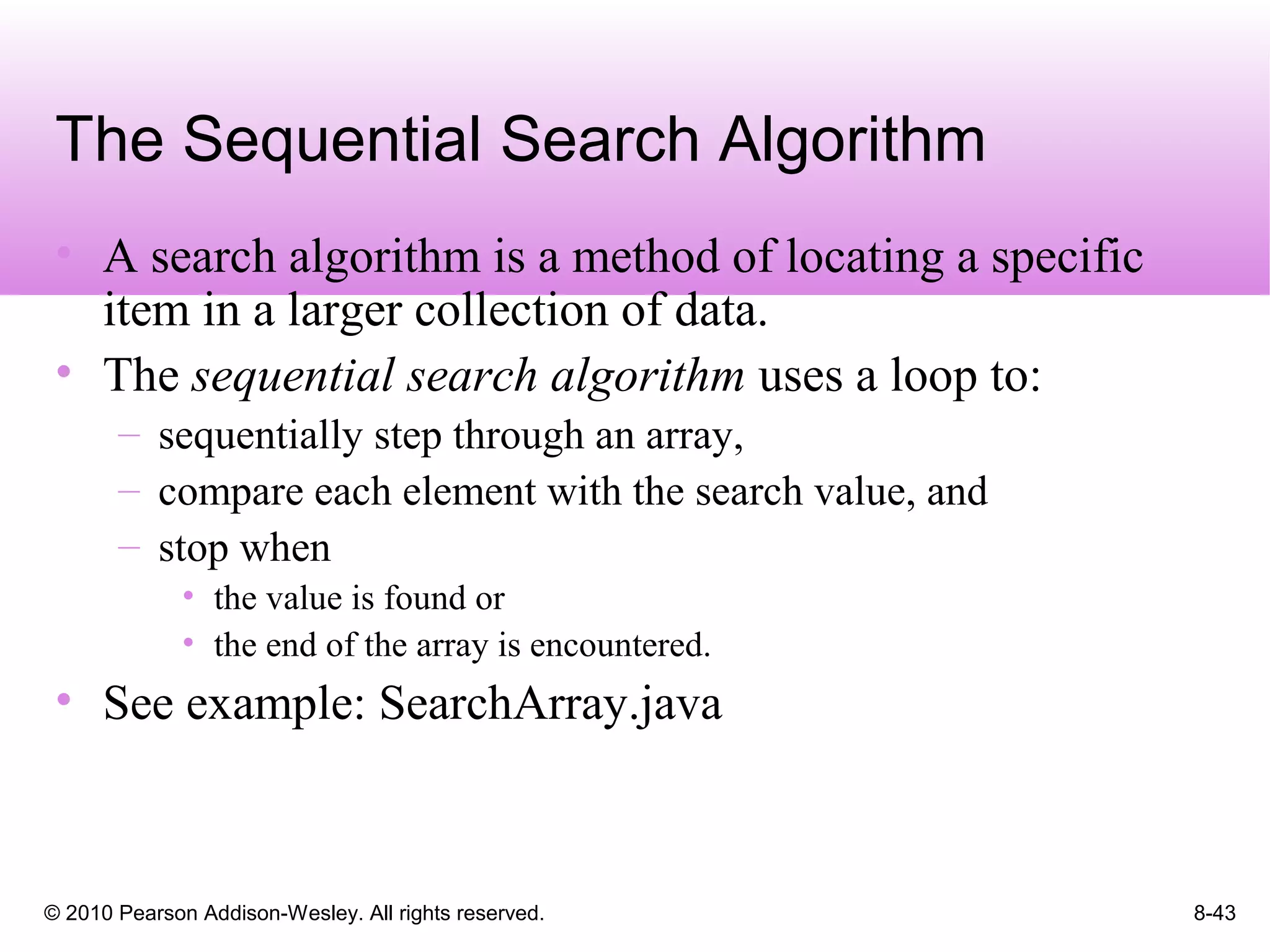
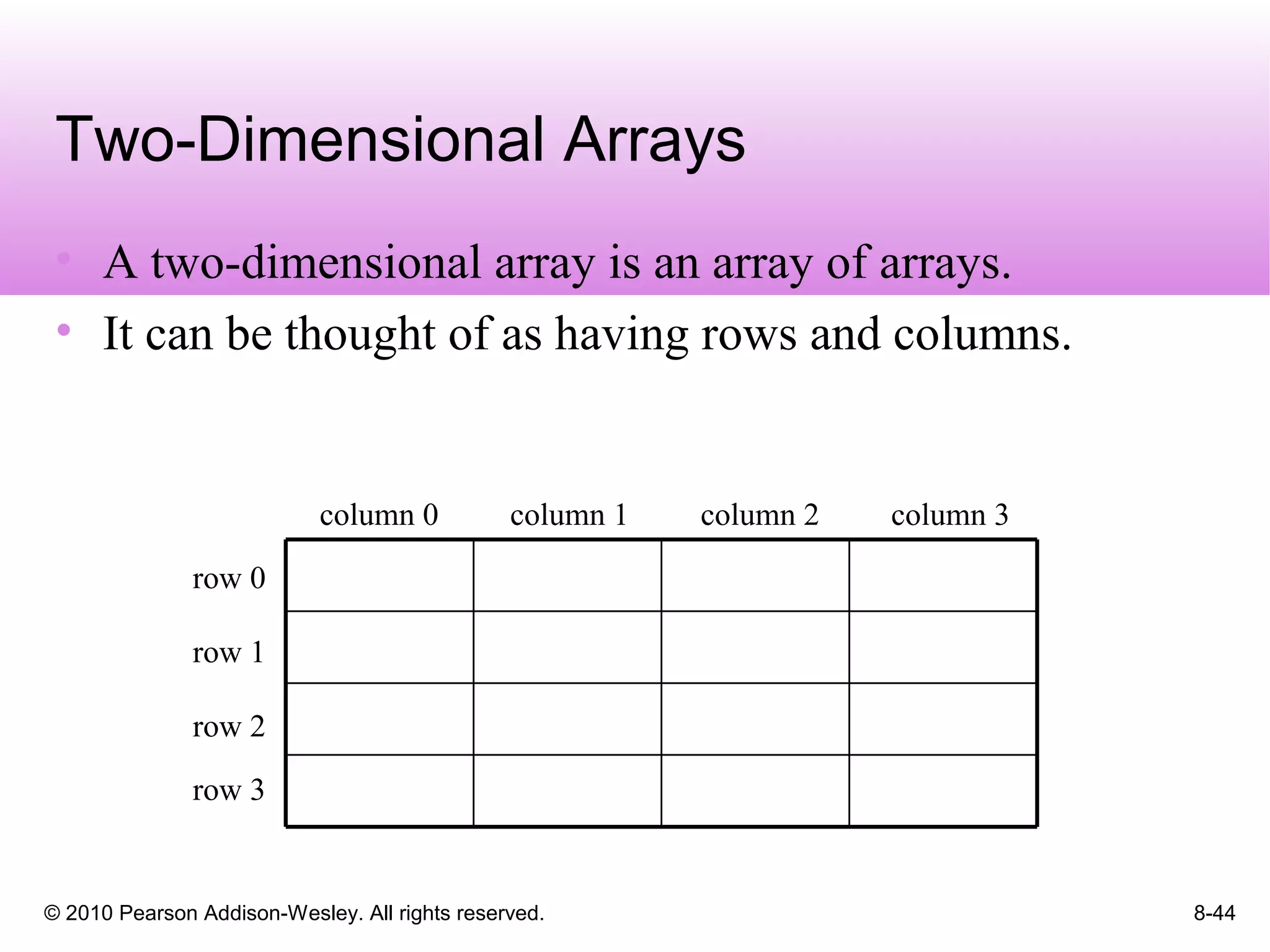
![© 2010 Pearson Addison-Wesley. All rights reserved. 8-45
• Declaring a two-dimensional array requires two sets of brackets
and two size declarators
– The first one is for the number of rows
– The second one is for the number of columns.
double[][] scores = new double[3][4];
• The two sets of brackets in the data type indicate that the scores
variable will reference a two-dimensional array.
• Notice that each size declarator is enclosed in its own set of
brackets.
Two-Dimensional Arrays
two dimensional array rows columns](https://image.slidesharecdn.com/csogaddisjavachapter8-130522082930-phpapp02/75/Cso-gaddis-java_chapter8-45-2048.jpg)
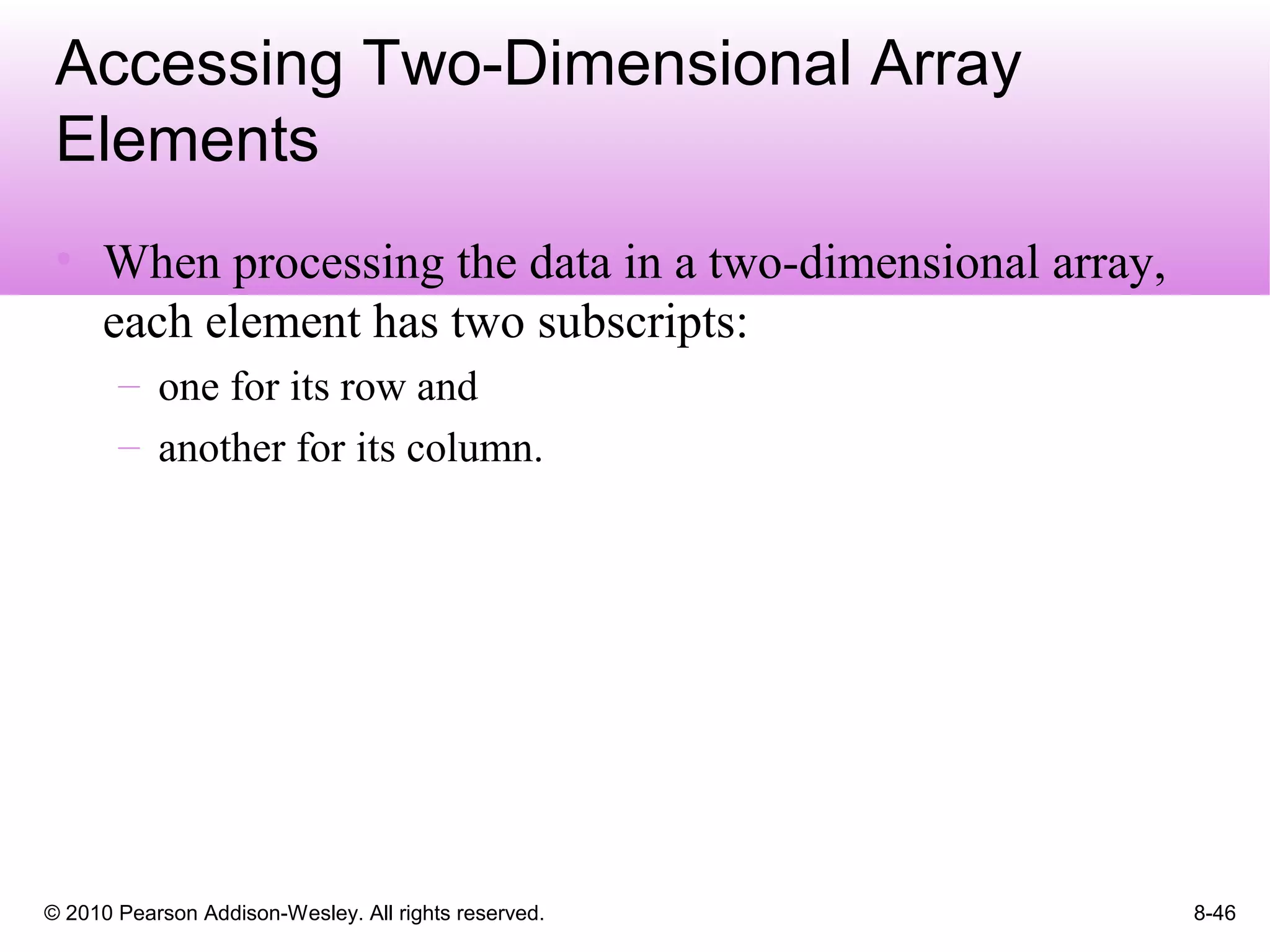
![© 2010 Pearson Addison-Wesley. All rights reserved. 8-47
Accessing Two-Dimensional Array
Elements
scores[0][3]scores[0][2]scores[0][1]scores[0][0]row 0
column 1 column 2 column 3column 0
row 1
row 2
The scores variable
holds the address of a
2D array of doubles.
Address
scores[1][3]scores[1][2]scores[1][1]scores[1][0]
scores[2][3]scores[2][2]scores[2][1]scores[2][0]](https://image.slidesharecdn.com/csogaddisjavachapter8-130522082930-phpapp02/75/Cso-gaddis-java_chapter8-47-2048.jpg)
![© 2010 Pearson Addison-Wesley. All rights reserved. 8-48
Accessing Two-Dimensional Array
Elements
Accessing one of the elements in a two-
dimensional array requires the use of both
subscripts.
scores[2][1] = 95;
0000row 0
column 1 column 2 column 3column 0
row 1
row 2
Address
0000
00950
The scores variable
holds the address of a
2D array of doubles.](https://image.slidesharecdn.com/csogaddisjavachapter8-130522082930-phpapp02/75/Cso-gaddis-java_chapter8-48-2048.jpg)
![© 2010 Pearson Addison-Wesley. All rights reserved. 8-49
Accessing Two-Dimensional Array
Elements
• Programs that process two-dimensional arrays can do
so with nested loops.
• To fill the scores array:
for (int row = 0; row < 3; row++)
{
for (int col = 0; col < 4; col++)
{
System.out.print("Enter a score: ");
scores[row][col] = keyboard.nextDouble();
}
}
Number of rows, not the
largest subscript
Number of
columns, not the
largest subscript
keyboard references a
Scanner object](https://image.slidesharecdn.com/csogaddisjavachapter8-130522082930-phpapp02/75/Cso-gaddis-java_chapter8-49-2048.jpg)
![© 2010 Pearson Addison-Wesley. All rights reserved. 8-50
Accessing Two-Dimensional Array
Elements
• To print out the scores array:
for (int row = 0; row < 3; row++)
{
for (int col = 0; col < 4; col++)
{
System.out.println(scores[row][col]);
}
}
• See example: CorpSales.java](https://image.slidesharecdn.com/csogaddisjavachapter8-130522082930-phpapp02/75/Cso-gaddis-java_chapter8-50-2048.jpg)
![© 2010 Pearson Addison-Wesley. All rights reserved. 8-51
Initializing a Two-Dimensional Array
• Initializing a two-dimensional array requires enclosing each
row’s initialization list in its own set of braces.
int[][] numbers = { {1, 2, 3}, {4, 5, 6}, {7, 8, 9} };
• Java automatically creates the array and fills its elements with
the initialization values.
– row 0 {1, 2, 3}
– row 1 {4, 5, 6}
– row 2 {7, 8, 9}
• Declares an array with three rows and three columns.](https://image.slidesharecdn.com/csogaddisjavachapter8-130522082930-phpapp02/75/Cso-gaddis-java_chapter8-51-2048.jpg)
![© 2010 Pearson Addison-Wesley. All rights reserved. 8-52
Initializing a Two-Dimensional Array
321row 0
column 1 column 2column 0
row 1
row 2
Address
654
987
The numbers variable
holds the address of a
2D array of int values.
int[][] numbers = {{1, 2, 3},
{4, 5, 6},
{7, 8, 9}};
produces:](https://image.slidesharecdn.com/csogaddisjavachapter8-130522082930-phpapp02/75/Cso-gaddis-java_chapter8-52-2048.jpg)
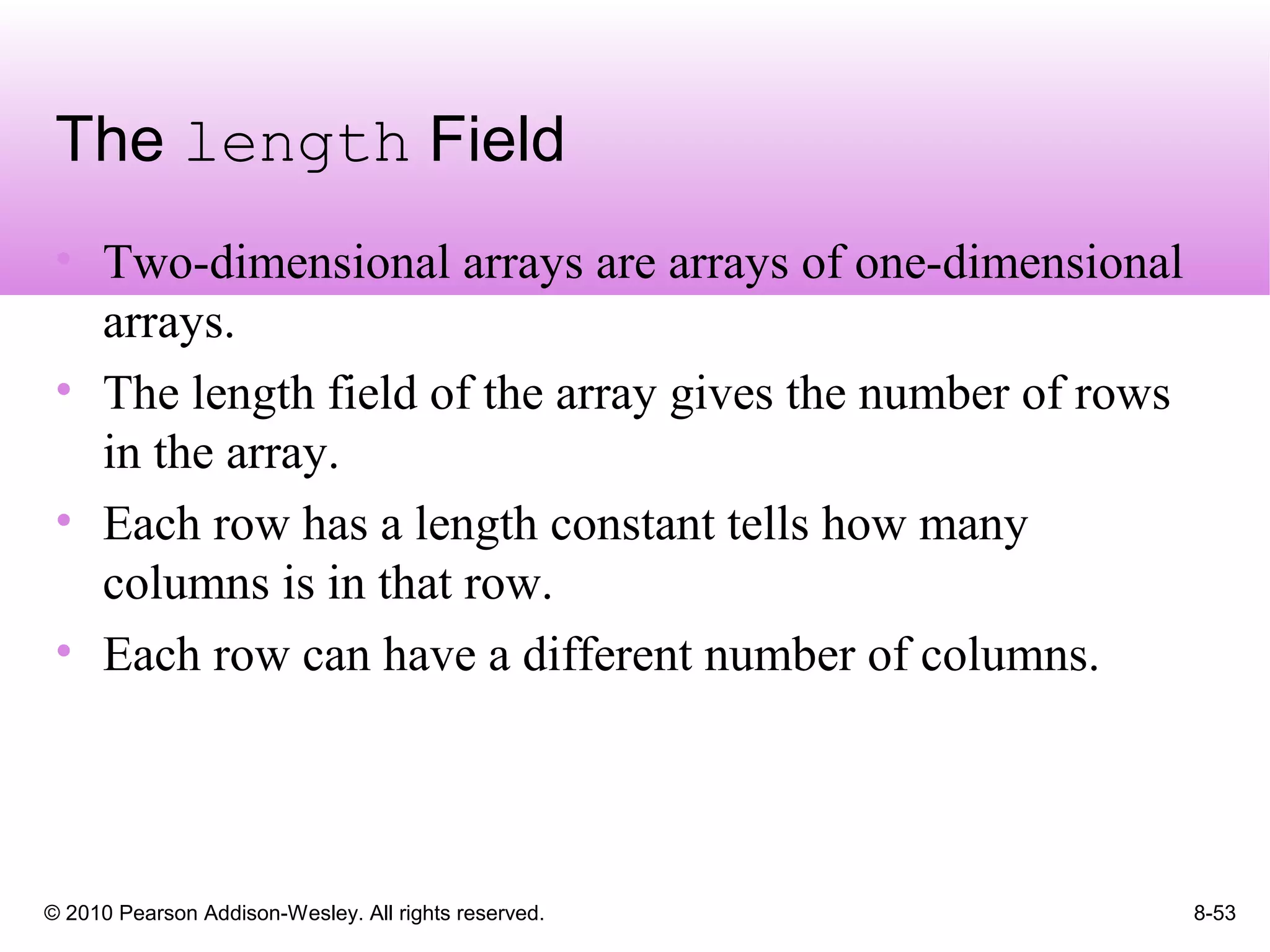
![© 2010 Pearson Addison-Wesley. All rights reserved. 8-54
The length Field
• To access the length fields of the array:
int[][] numbers = { { 1, 2, 3, 4 },
{ 5, 6, 7 },
{ 9, 10, 11, 12 } };
for (int row = 0; row < numbers.length; row++)
{
for (int col = 0; col < numbers[row].length; col++)
System.out.println(numbers[row][col]);
}
• See example: Lengths.java
Number of rows Number of columns in this row.
The array can have variable length rows.](https://image.slidesharecdn.com/csogaddisjavachapter8-130522082930-phpapp02/75/Cso-gaddis-java_chapter8-54-2048.jpg)
![© 2010 Pearson Addison-Wesley. All rights reserved. 8-55
Summing The Elements of a Two-
Dimensional Array
int[][] numbers = { { 1, 2, 3, 4 },
{5, 6, 7, 8},
{9, 10, 11, 12} };
int total;
total = 0;
for (int row = 0; row < numbers.length; row++)
{
for (int col = 0; col < numbers[row].length; col++)
total += numbers[row][col];
}
System.out.println("The total is " + total);](https://image.slidesharecdn.com/csogaddisjavachapter8-130522082930-phpapp02/75/Cso-gaddis-java_chapter8-55-2048.jpg)
![© 2010 Pearson Addison-Wesley. All rights reserved. 8-56
Summing The Rows of a Two-
Dimensional Array
int[][] numbers = {{ 1, 2, 3, 4},
{5, 6, 7, 8},
{9, 10, 11, 12}};
int total;
for (int row = 0; row < numbers.length; row++)
{
total = 0;
for (int col = 0; col < numbers[row].length; col++)
total += numbers[row][col];
System.out.println("Total of row "
+ row + " is " + total);
}](https://image.slidesharecdn.com/csogaddisjavachapter8-130522082930-phpapp02/75/Cso-gaddis-java_chapter8-56-2048.jpg)
![© 2010 Pearson Addison-Wesley. All rights reserved. 8-57
Summing The Columns of a Two-
Dimensional Array
int[][] numbers = {{1, 2, 3, 4},
{5, 6, 7, 8},
{9, 10, 11, 12}};
int total;
for (int col = 0; col < numbers[0].length; col++)
{
total = 0;
for (int row = 0; row < numbers.length; row++)
total += numbers[row][col];
System.out.println("Total of column "
+ col + " is " + total);
}](https://image.slidesharecdn.com/csogaddisjavachapter8-130522082930-phpapp02/75/Cso-gaddis-java_chapter8-57-2048.jpg)
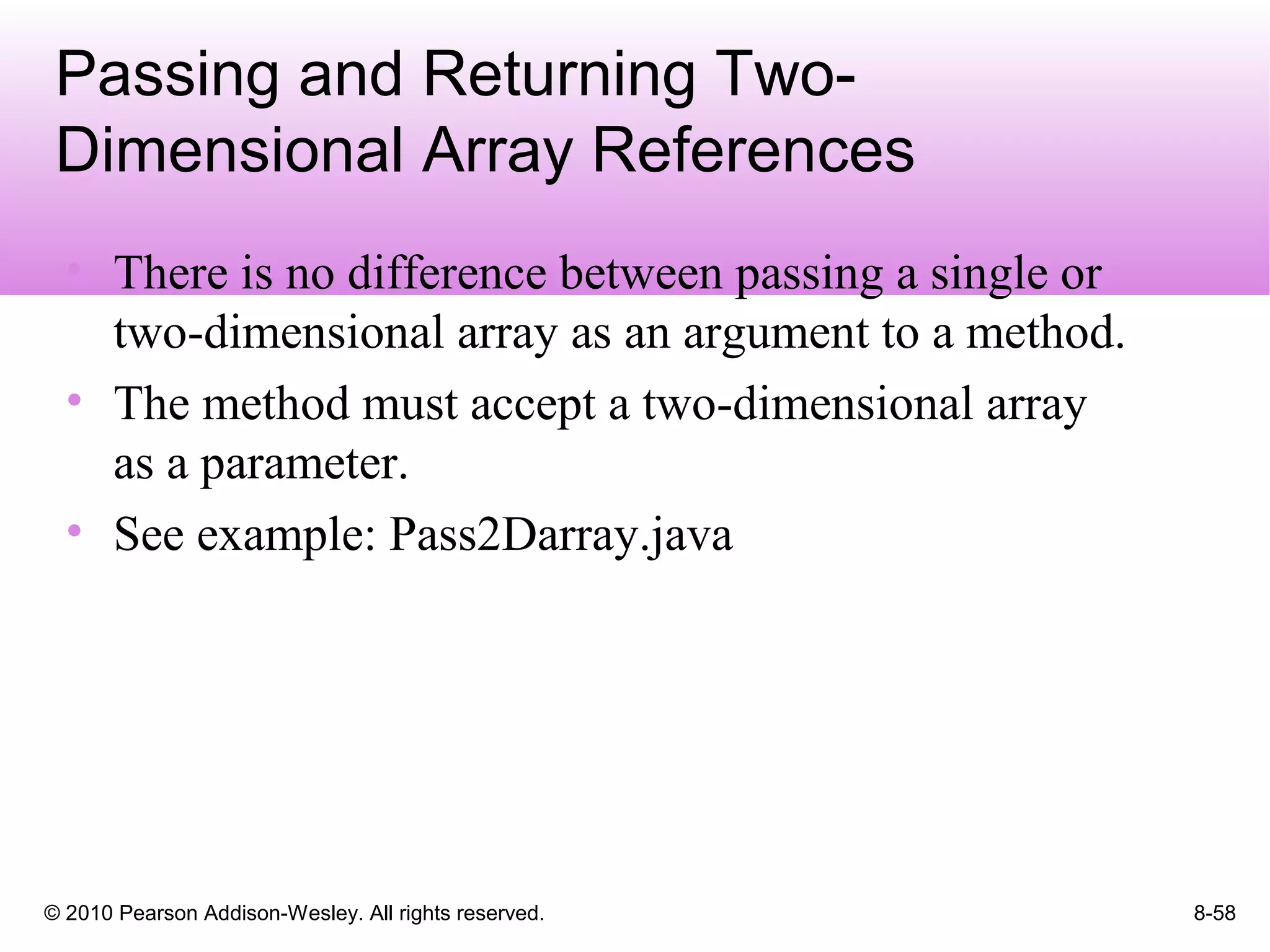
![© 2010 Pearson Addison-Wesley. All rights reserved. 8-59
Ragged Arrays
• When the rows of a two-dimensional array are of different
lengths, the array is known as a ragged array.
• You can create a ragged array by creating a two-
dimensional array with a specific number of rows, but no
columns.
int [][] ragged = new int [4][];
• Then create the individual rows.
ragged[0] = new int [3];
ragged[1] = new int [4];
ragged[2] = new int [5];
ragged[3] = new int [6];](https://image.slidesharecdn.com/csogaddisjavachapter8-130522082930-phpapp02/75/Cso-gaddis-java_chapter8-59-2048.jpg)
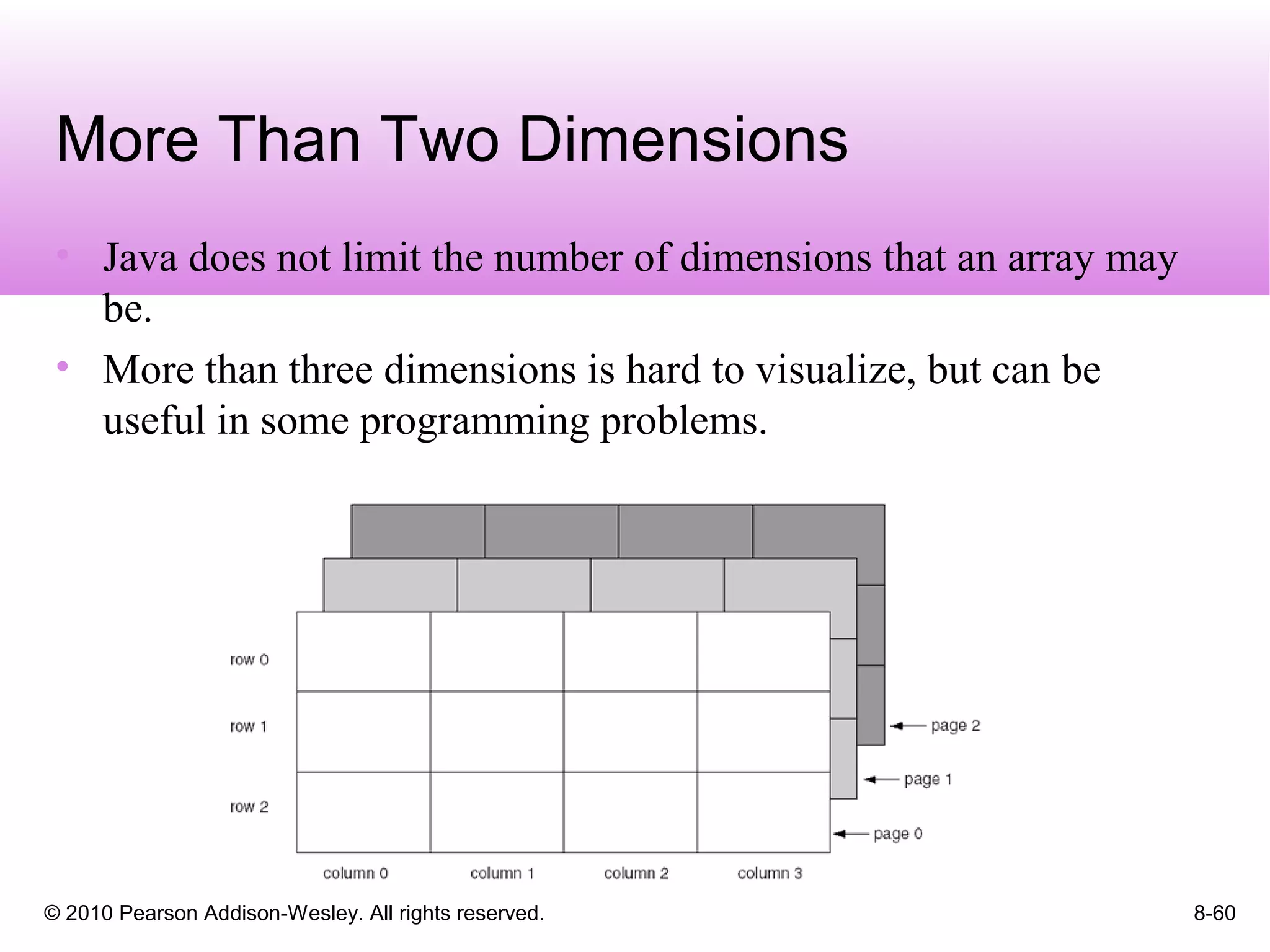
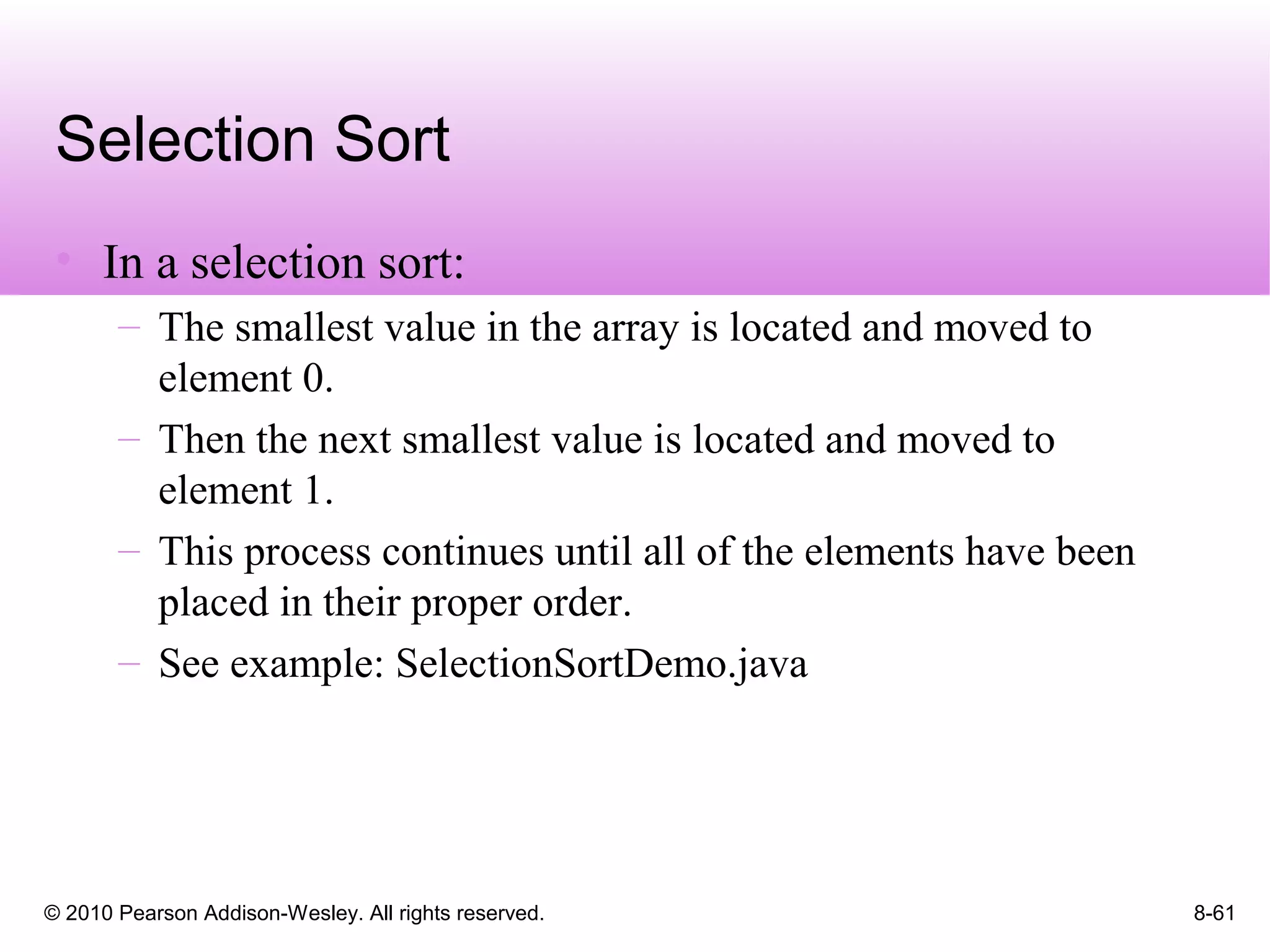

![© 2010 Pearson Addison-Wesley. All rights reserved. 8-63
Command-Line Arguments
• A Java program can receive arguments from the operating
system command-line.
• The main method has a header that looks like this:
public static void main(String[] args)
• The main method receives a String array as a parameter.
• The array that is passed into the args parameter comes from
the operating system command-line.](https://image.slidesharecdn.com/csogaddisjavachapter8-130522082930-phpapp02/75/Cso-gaddis-java_chapter8-63-2048.jpg)
![© 2010 Pearson Addison-Wesley. All rights reserved. 8-64
Command-Line Arguments
• To run the example:
java CommandLine How does this work?
args[0] is assigned "How"
args[0] is assigned "does"
args[0] is assigned "this"
args[0] is assigned "work?"
• Example: CommandLine.java
• It is not required that the name of main’s
parameter array be args.](https://image.slidesharecdn.com/csogaddisjavachapter8-130522082930-phpapp02/75/Cso-gaddis-java_chapter8-64-2048.jpg)
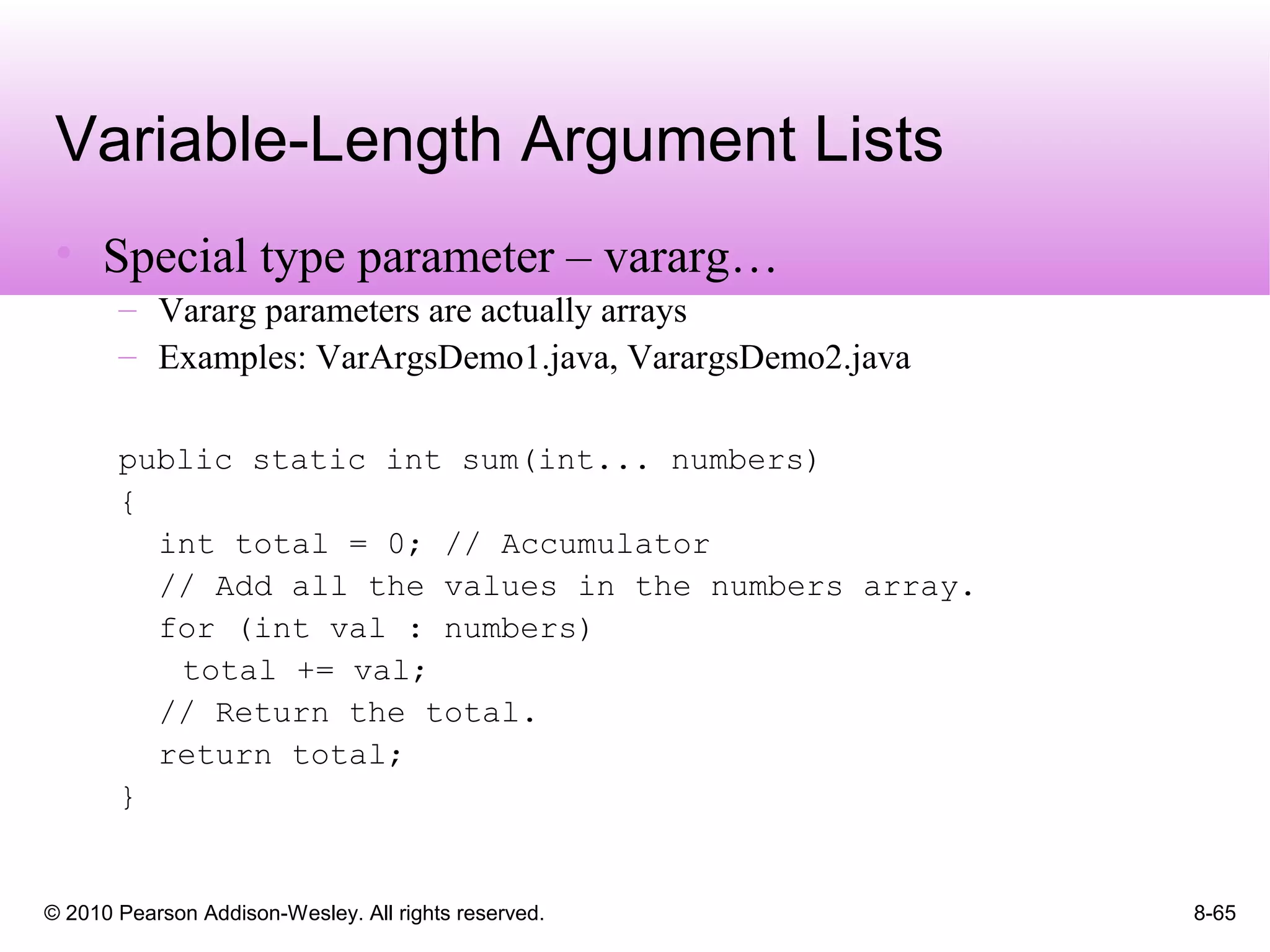
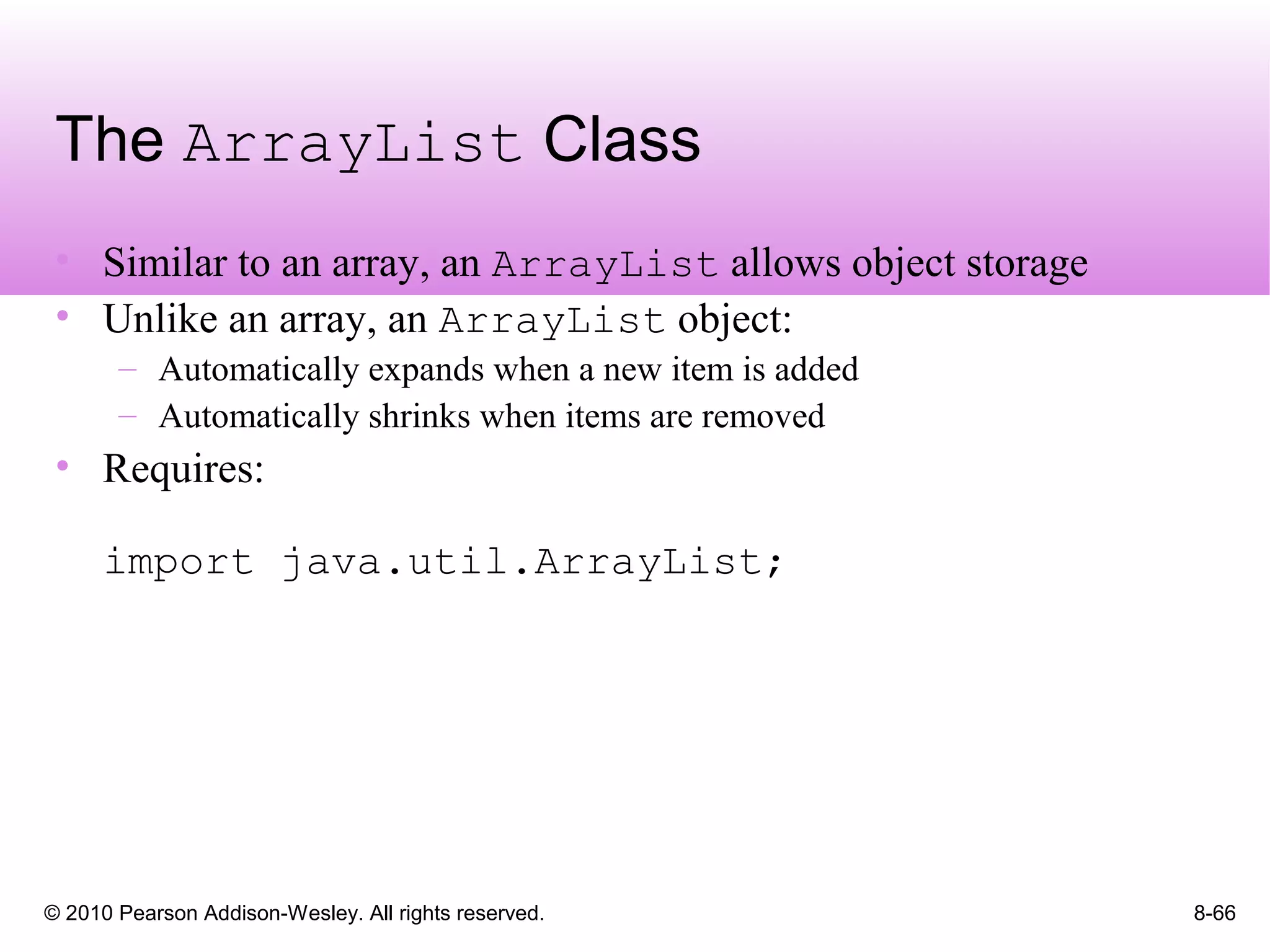
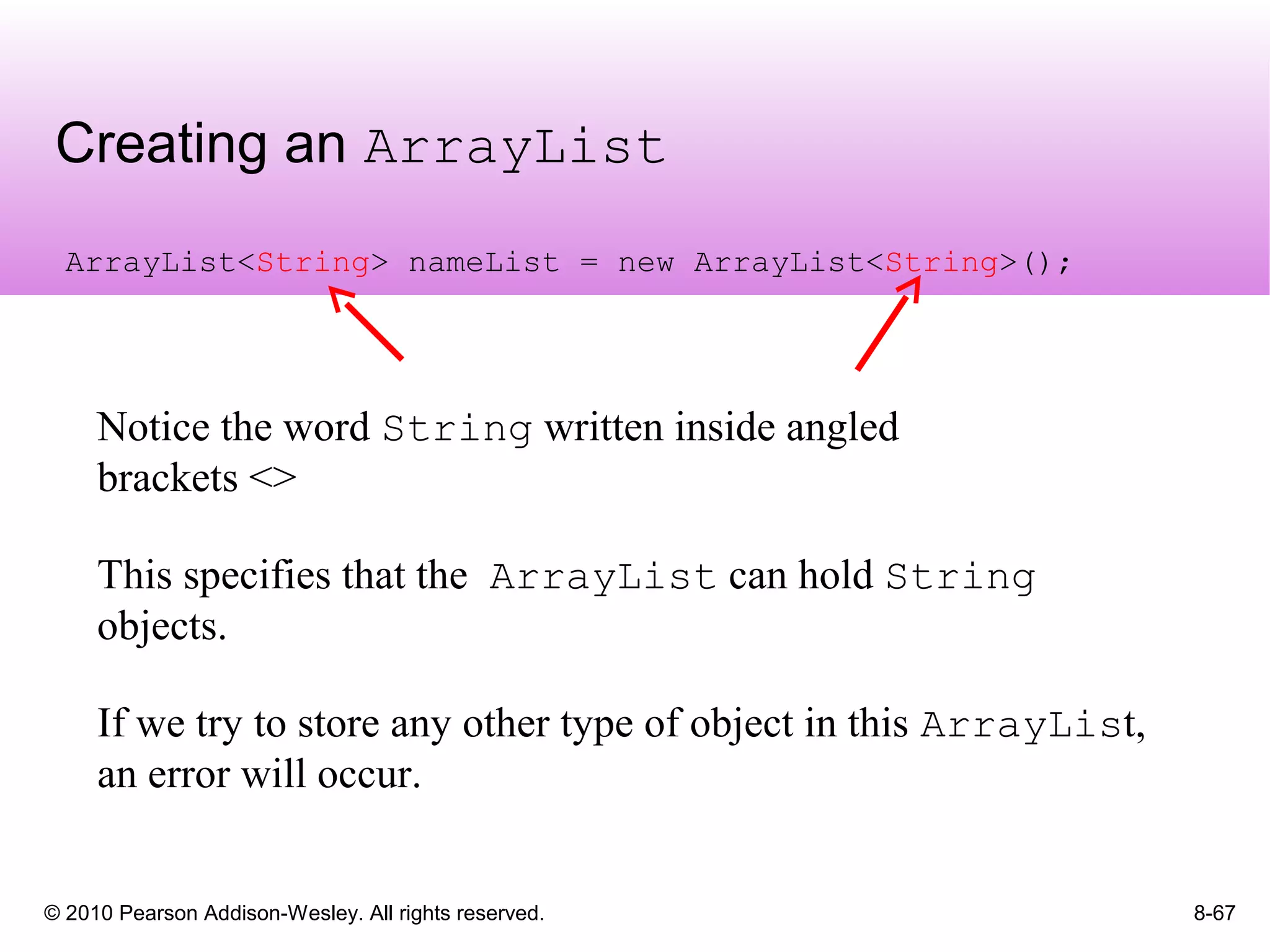
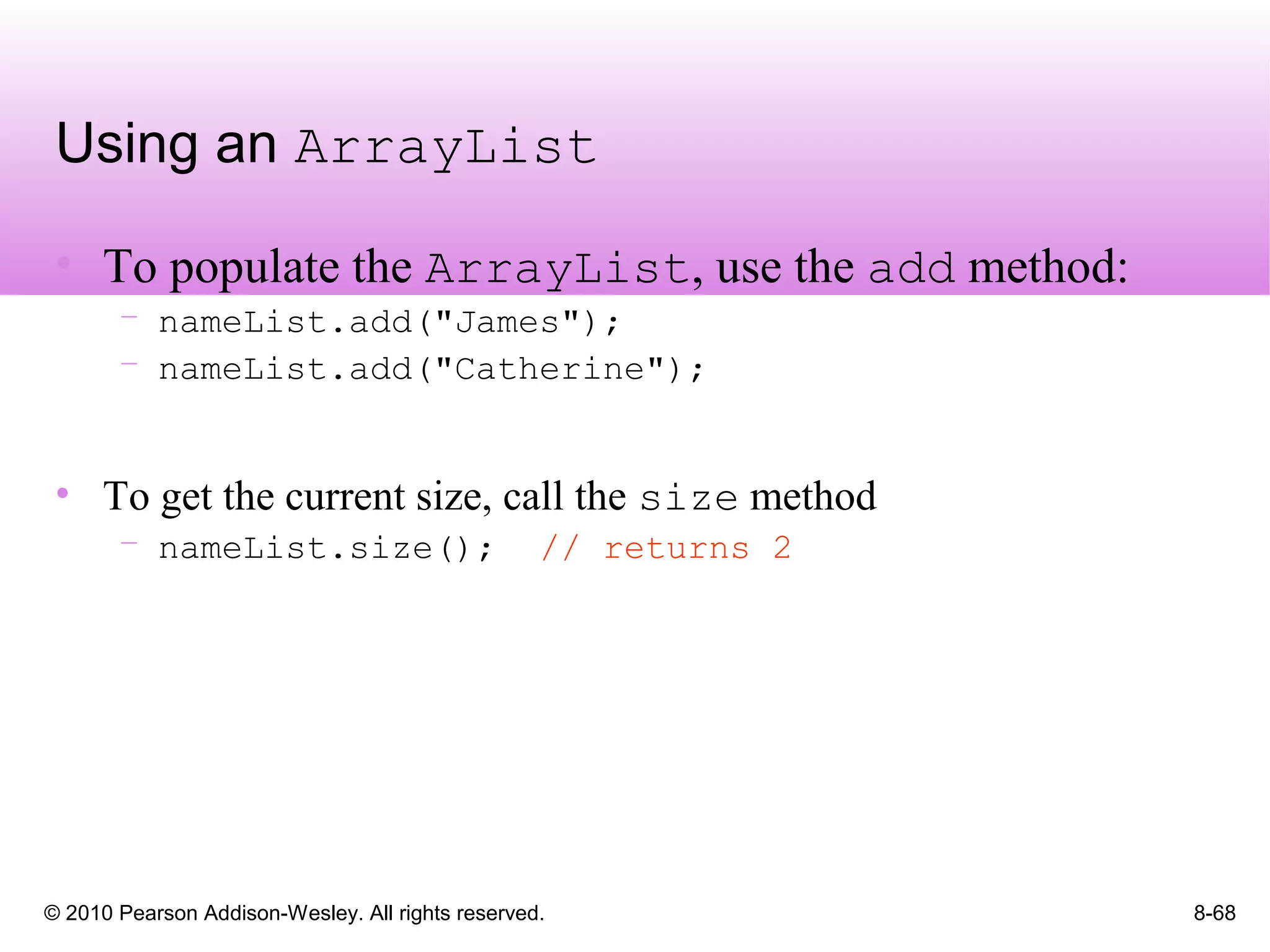
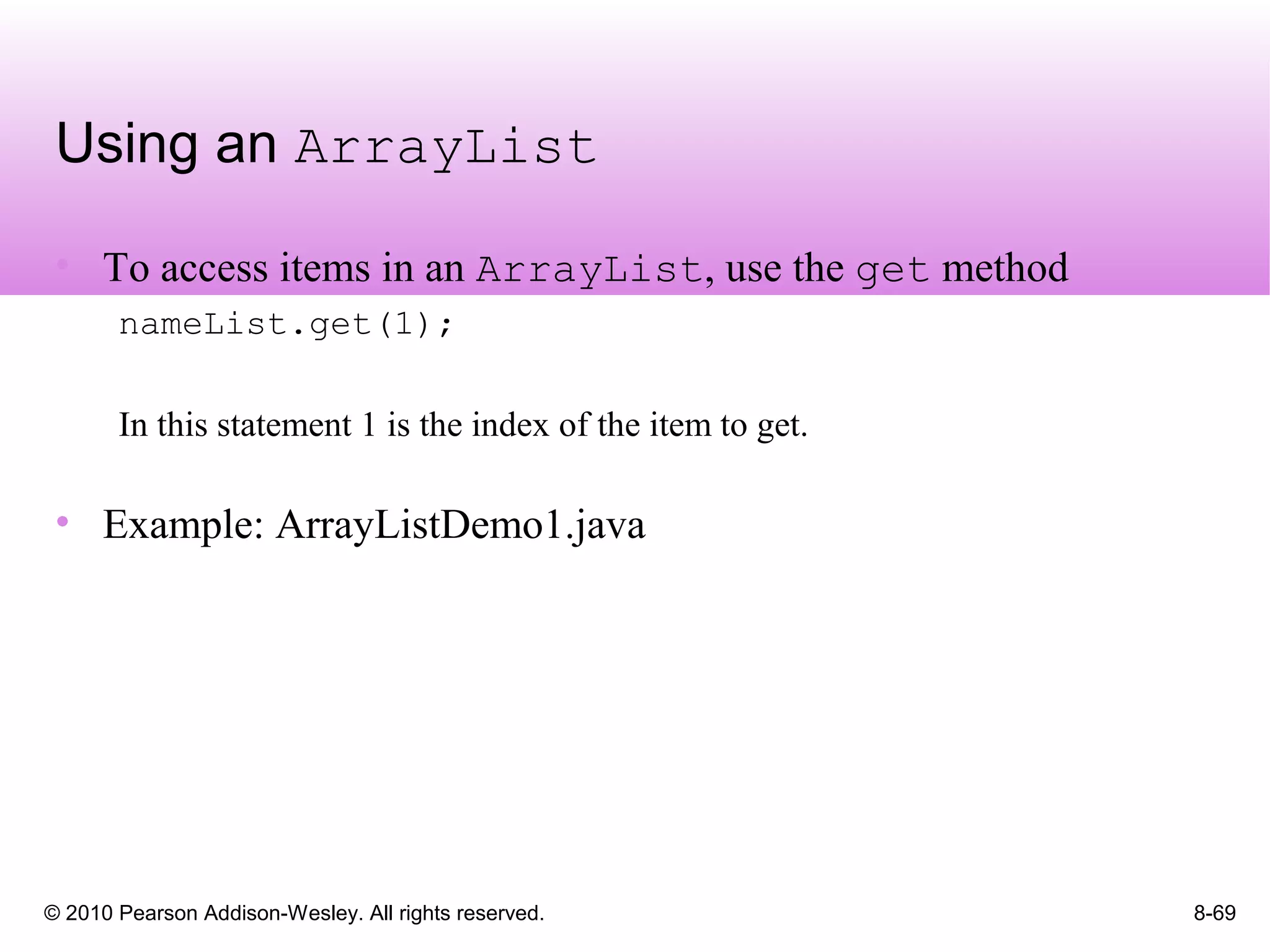
![© 2010 Pearson Addison-Wesley. All rights reserved. 8-70
Using an ArrayList
• The ArrayList class's toString method returns a string
representing all items in the ArrayList
System.out.println(nameList);
This statement yields :
[ James, Catherine ]
• The ArrayList class's remove method removes designated
item from the ArrayList
nameList.remove(1);
This statement removes the second item.
• See example: ArrayListDemo3.java](https://image.slidesharecdn.com/csogaddisjavachapter8-130522082930-phpapp02/75/Cso-gaddis-java_chapter8-70-2048.jpg)
